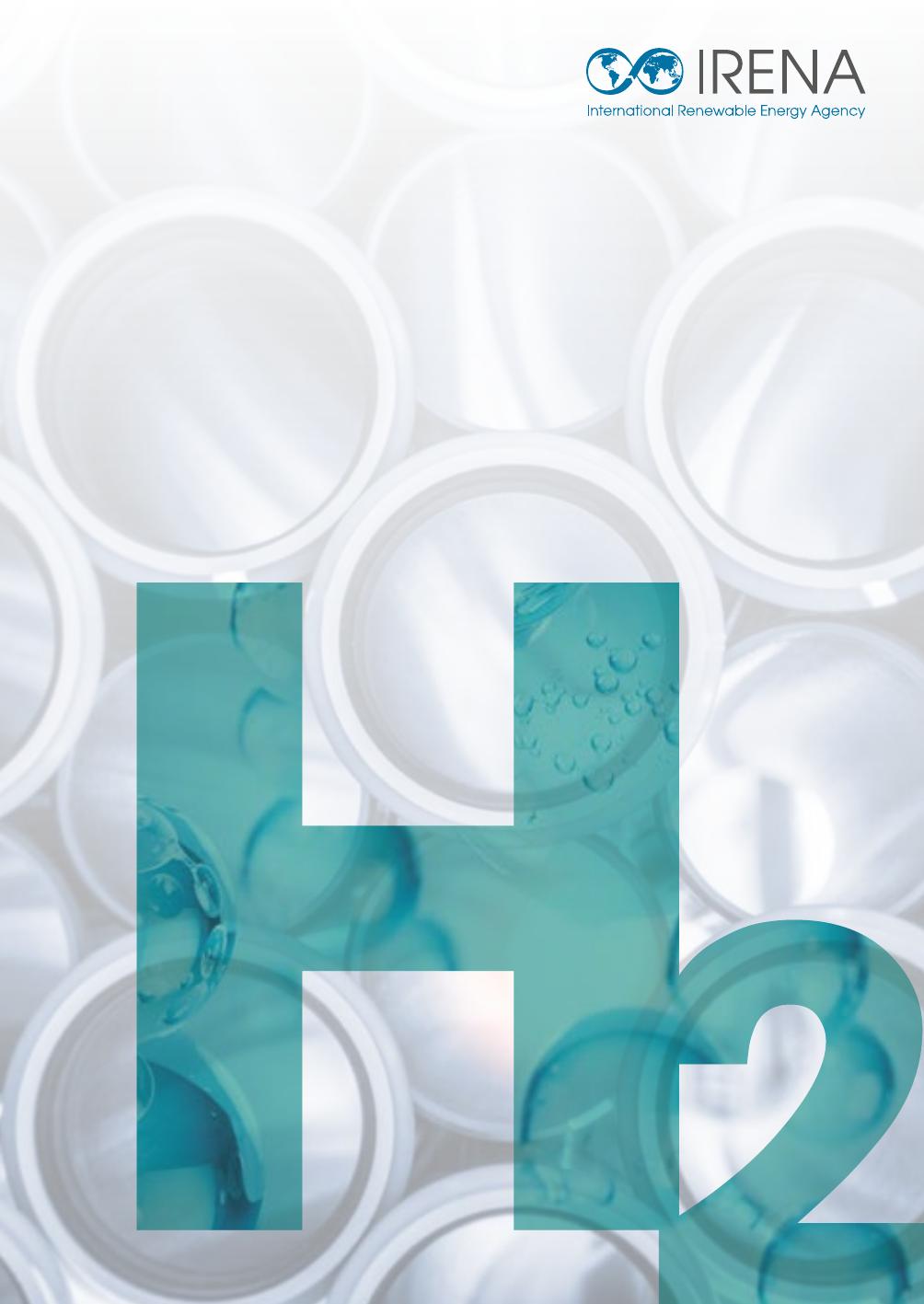GREENHYDROGENFORINDUSTRYAGUIDETOPOLICYMAKING©IRENA2022Unlessotherwisestated,materialinthispublicationmaybefreelyused,shared,copied,reproduced,printedand/orstored,providedthatappropriateacknowledgementisgivenofIRENAasthesourceandcopyrightholder.Materialinthispublicationthatisattributedtothirdpartiesmaybesubjecttoseparatetermsofuseandrestrictions,andappropriatepermissionsfromthesethirdpartiesmayneedtobesecuredbeforeanyuseofsuchmaterial.Citation:�IRENA(2022),Greenhydrogenforindustry:Aguidetopolicymaking,InternationalRenewableEnergyAgency,AbuDhabi.ISBN:978-92-9260-422-6ABOUTIRENATheInternationalRenewableEnergyAgency(IRENA)servesastheprincipalplatformforinternationalco-operation,acentreofexcellence,arepositoryofpolicy,technology,resourceandfinancialknowledge,andadriverofactiononthegroundtoadvancethetransformationoftheglobalenergysystem.Anintergovernmentalorganisationestablishedin2011,IRENApromotesthewidespreadadoptionandsustainableuseofallformsofrenewableenergy,includingbioenergy,geothermal,hydropower,ocean,solarandwindenergy,inthepursuitofsustainabledevelopment,energyaccess,energysecurityandlow-carboneconomicgrowthandprosperity.www.irena.orgDISCLAIMERThispublicationandthematerialhereinareprovided“asis”.AllreasonableprecautionshavebeentakenbyIRENAtoverifythereliabilityofthematerialinthispublication.However,neitherIRENAnoranyofitsofficials,agents,dataorotherthird-partycontentprovidersprovidesawarrantyofanykind,eitherexpressedorimplied,andtheyacceptnoresponsibilityorliabilityforanyconsequenceofuseofthepublicationormaterialherein.TheinformationcontainedhereindoesnotnecessarilyrepresenttheviewsofallMembersofIRENA.ThementionofspecificcompaniesorcertainprojectsorproductsdoesnotimplythattheyareendorsedorrecommendedbyIRENAinpreferencetoothersofasimilarnaturethatarenotmentioned.Thedesignationsemployed,andthepresentationofmaterialherein,donotimplytheexpressionofanyopiniononthepartofIRENAconcerningthelegalstatusofanyregion,country,territory,cityorareaorofitsauthorities,orconcerningthedelimitationoffrontiersorboundaries.2GREENHYDROGENFORINDUSTRYAGUIDETOPOLICYMAKINGACKNOWLEDGEMENTSThereportwasdevelopedundertheguidanceofRabiaFerroukhiandUteCollierandauthoredbyEmanueleBianco,SufyanDiabandHeribBlanco.IRENAcolleaguesDialaHawila,HanbitLee,EmanueleTaibi,BarbaraJinks,RanyaOualid,GabrielCastellanosandFranciscoBoshellprovidedvaluableinput.MassimoSantarelliandMartaGandiglio(PolytechnicUniversityofTurin)providedtechnicalcontributionstothereport.CédricPhilibertprovidedimportantandwelcomedcontributionsandobservations.Thereportbenefitedalsofromthereviewsandcommentsofexperts,includingElviraLopezPradoandAndreaRealRuiz(Acciona),MatthiasDeutsch,GniewomirFlisandPaulMünnich(AgoraEnergiewende),SuhailShatila(Apricorp),MartinoComelli(AmericanUniversityofCentralAsia),LinZhang(ChinaHydrogenAlliance),FrankWouters(EU-GCCCleanEnergyTechnologyNetwork),EvaVitell(Hybrit),JoseMiguelBermudez(IEA),MartaMartínez(Iberdrola),TomasKåbergerandYukoNishida,(RenewableEnergyInstitute),JiChen(RockyMountainInstitute),AidanCronin(SiemensGamesa),ThierryLepercq(Soladvent),PetraSchwagerandSmeetaFokeer(UNIDO),ChristinTöpfer(Vattenfall),SripathiAnirudh,KajolandDeepakKrishnan(WorldResourcesInstitute).Availablefordownload:www.irena.org/publicationsForfurtherinformationortoprovidefeedback:publications@irena.org3CONTENTSAbbreviations06Unitsofmeasure06INTRODUCTION08Aboutthisreport08Hard-to-abatesectorsandgreenhydrogen11Prioritysettingingreenhydrogenpolicymaking12Theexperienceinthepowersector151.POTENTIALGREENHYDROGENUSESININDUSTRYANDRELATEDBARRIERS161.1.Currentstatusandpotentialuses161.2.Barriers232.POLICIESTOPROMOTEGREENHYDROGENININDUSTRY302.1.Green(hydrogen)industrialpolicies342.2.Industrialdecarbonisationstrategies352.3.Technologicalmandates382.4.Carbonpricing40INFOCUS:Addressingcarbonleakage442.5.Financialandfiscalsupport482.6.Creatingthemarketforgreenproducts542.7.R&D603.THEWAYFORWARD61References644TABLEOFCONTENTFIGURESFigurei.1Greenhydrogenvaluechainandthefocusofthisreport......................-00009Figurei.2�Greenhydrogenpolicypriority..............................................13Figure1.1�Purehydrogendemandinindustry,global,2020................................17Figure1.2�Mainsteelproductionpathways.................................................20Figure1.3�Workingtemperaturesforselectedrenewableheattechnologiesandtemperaturerequirementofselectedindustries...........................................22Figure2.1�Barriersandpoliciestosupportgreenhydrogenuptakeintheindustrialsector......31Figure2.2�Selectedgreenhydrogenforindustrypoliciesbystatus,selectedcountries,2022...32Figure2.3�Estimatedcarbonpricesneededtocoverthecostgapbetweengreenandgreymaterials............................................................40Figure2.4�CarbonallowancepriceintheEuropeanUnion,2008-2020......................42Figure2.5�SchematicofaBCA.......................................................45Figure2.6�FlatvscarboncontentBCAtariffs...........................................46Figure2.7�RelationshipbetweenaverageETSpriceandCCfDsubsidyatstrikepriceofUSD65/tCO2...........................................................50Figure2.8�Bilateralauctionsystemschematic..........................................53Figure2.9�Materialrequiredtobuilda500MWsolarplant,onshorewindplantoroffshorewindplant.......................................................57Figure3.1�Roadmapofpoliciestopromotehydrogenuseinindustryacrossthreestagesofdeployment............................................................62BOXESBoxi.1IRENA’sworkongreenhydrogenandhard-to-abatesectors.......................10Boxi.2Prioritysettingingreenhydrogenpolicymaking.................................12Box1.1Hydrogeninoilrefineries.....................................................17Box1.2Costsofgreenhydrogenandmaterials.........................................24Box1.3�Industrialcompanieswithhydrogen-relateddecarbonisationtargets–selectedexamples..........................................................26Box1.4TheGlasgowBreakthroughs..................................................29Box2.1Germanhydrogenstrategy...................................................33Box2.2UKIndustrialDecarbonisationStrategy.........................................37Box2.3Procurementofgreensteelthroughauctionsforrenewableenergy.................56Box2.4Ecoleaf....................................................................595BCABordercarbonadjustmentBECCS�BioenergywithcarboncaptureandstorageBFBlastfurnaceBF-BOFBlastfurnace-basicoxygenfurnaceCCfDCarboncontractfordifferenceCCSCarboncaptureandstorageCCUSCarboncaptureutilisationandstorageCO2CarbondioxideCOPCoefficientofperformanceDACDirectaircaptureDRIDirectreductionofironEAFElectricarcfurnaceETSEmissionstradingsystemEVElectricvehicleFCEVFuelcellelectricvehicleFIPFeed-inpremiumFITFeed-intariffGHGGreenhousegasH2HydrogenNOxNitrogenoxideOBPSOutput-basedpricingsystemPtHPower-to-heatPVPhotovoltaicSMRSteammethanereformingSPPSustainablepublicprocurementWTOWorldTradeOrganizationEJExajouleGJGigajouleGtGigatonneGWGigawattkgKilogramkWKilowattkWhKilowatthourm3CubicmetreMtMegatonneMWMegawattMWhMegawatthourPWhPetawatthourtTonneTWhTerawatthouryrYearABBREVIATIONSUNITSOFMEASUREABBREVIATIONS6GREENHYDROGENFORINDUSTRYAGUIDETOPOLICYMAKING7INTRODUCTIONABOUTTHISREPORTGreenhydrogen1isbenefitingfromanewwaveofinterestduetoitspotentialtomakeasignificantcontributiontomeetingclimategoalsandadvancingtheenergytransition.Inresponse,IRENAhasbeenanalysingoptionsfortheproductionandconsumptionofgreenhydrogen,alongwithdevisingpoliciestosupportandaccelerateitscommercialisationandwideadoption(seeBoxi.1).In2020IRENApublishedaninitialreportfocusingongreenhydrogenpolicies:Greenhydrogen:Aguidetopolicymaking(IRENA,2020a).Itoutlinesthemainbarrierstotheuptakeofgreenhydrogenandthekeypillarsforeffectivepolicymaking.Italsocreatesaframeworkfordiscussionaboutgreenhydrogenpolicymaking.Thegreenhydrogenvaluechain,fromproductiontoconsumption,consistsofmultipleelementsthatareinterlinkedwiththebroaderenergysector.Eachoftheseelementcanfacespecificbarriersandchallenges.IRENA,therefore,conceivedaseriesofreportsfocusingonthesechallengesandtheoptionstoovercomethem.TheIRENAreport,Greenhydrogensupply:Aguidetopolicymaking,examinesthepolicyoptionstosupporttheproductionofgreenhydrogenbywaterelectrolysis,itstransport,andtheoptionsforstorage(IRENA,2021a).Thepresentreportexploresthechallengesthatgreenhydrogenfacesintheindustrialsectorandthepolicyoptionsavailabletopolicymakerstoaddressthesechallenges.1�Greenhydrogenishydrogenproducedfromrenewableenergy.Sincethemostestablishedtechnologyoptionsforproducinggreenhydrogeniswaterelectrolysisfuelledbyrenewableelectricity,itwillbethefocusofthisreport.8©RattiyaThongdumhyu/shutterstock.com©GeckoStudio/shutterstock.com©PHOTOCREOMichalBednarek/shutterstock.comRenewableenergyElectrolysisSustainableCO2captureStoragePipelineSteelindustryChemicalindustryRefineriesTrucksShippingGreenammoniaSyntheticfuels222222CO2N22INDUSTRYPOWERGENERATIONHEATINGShippingAviationCarsRailTrucksBusesTRANSPORTPRODUCTIONFURTHERPROCESSINGENDUSEWITHOUTTRANSFORMATIONWITHTRANSFORMATIONTRANSFORMATIONNH3TRANSPORTATIONNH3Sources:IRENA(2020a)Figurei.1�Greenhydrogenvaluechainandthefocusofthisreport9©Nordroden/shutterstock.comGREENHYDROGENFORINDUSTRYBoxi.1IRENA’sworkongreenhydrogenandhard-to-abatesectorsThisreportispartofIRENA’songoingprogrammeofworktoprovideitsmembercountriesandthebroadercommunitywithexpertanalyticalinsightsintothepotentialoptions,theenablingconditionsandthepoliciesthatcoulddeliverthedeepdecarbonisationofeconomies.IRENA’sWorldEnergyTransitionsOutlookprovidesadetailedroadmapforemissionreductionsonapathwayconsistentwitha1.5°Cgoal,alongsideassessmentsofthesocio-economicimplications(IRENA,2021b).Buildingonthis,IRENAisanalysingspecificfacetsofthatpathway,includingthepolicyandfinancialframeworksneeded.RecentIRENApublicationsongreenhydrogeninclude:•Hydrogenfromrenewablepower(2018)•Hydrogen:Arenewableenergyperspective(2019)•Reachingzerowithrenewables(2020)anditssupportingbriefsonindustryandtransport•Greenhydrogen:Aguidetopolicymaking(2020)•Greenhydrogencostreduction:Scalingupelectrolyserstomeetthe1.5°Cclimategoal(2020)•Renewableenergypoliciesinatimeoftransition:Heatingandcooling(2020)•Greenhydrogensupply:Aguidetopolicymaking(2021)•EnablingMeasuresRoadmapforGreenHydrogen(2021),withtheWorldEconomicForum.•GeopoliticsoftheEnergyTransformation:TheHydrogenFactor(2022)ThesereportscomplementIRENA’sworkonrenewables-basedelectrification,biofuelsandsyntheticfuelsandalltheoptionsforspecifichard-to-abatesectors.ThisanalyticalworkissupportedbyIRENA’sinitiativestoconveneexpertsandstakeholders,includingIRENAInnovationWeeks,IRENAPolicyDaysandPolicyTalks,andtheIRENACollaborativeFrameworkonGreenHydrogen.Theseinitiativesbringtogetherabroadrangeofmembercountriesandotherstakeholderstoexchangeknowledgeandexperience.H1.01Hydrogen210HARD-TO-ABATESECTORSANDGREENHYDROGENEnergy-intensiveindustriesproducingbasicmaterials,suchasironandsteelandchemicals,areresponsibleforalargeshareofgreenhousegas(GHG)emissions.Theironandsteelandchemicalsectorsaloneemittedabout8%and5%respectivelyofthe36.9Gtofglobalenergy-andprocess-relatedGHGemissionsin2017(IRENA,2020b).Theemissionsfromtheseenergy-intensiveindustrieshaveincreasedsteadilywiththegrowingglobaldemandformaterials,driveninturnbyincreasedglobalwealthandurbanpopulations,andassociatedinfrastructuredevelopment(Lambetal.,2021).Reversingthistrendandaligningtheindustrialemissionstrajectorywiththegoalsofmitigatingtheclimatecrisisisanurgentandchallengingtask.Materialindustriesareanintegralpartofoursociety;therelatedpoliciesandsocialinstitutionsco-evolvedwiththem,oftenaimingtokeepthemcompetitiveinaglobalmarket.Asaresult,theseindustrieshavebecomehighlyefficientbutfossil-fueldependentintheirproductionsystems,resultingin“carbonlock-in”(Åhman,2020).Intheironandsteelindustry,forexample,40%ofthe21EJconsumedin2019camefromcoal,33%fromfossilgasesand20%fromelectricity(IEA,2021a).Inaddition,demandforbasicmaterialsisexpectedtocontinueincreasing,drivenbyeconomicgrowthandtheinfrastructureneedsofanetzerofuture.Ithasbecomecommontolisttheironandsteelandchemicalindustriesamongthe“hard-to-abate”sectors.Thisisbecauseoftheirprocessenergyneedsandemissions,forwhichtheabatementchallengesaremany,includingthecurrentmaterialusemodel(withlimitedrecoveryafteruse),thefactthatthethermodynamicefficiencyofcoreprocesseshasbeenmaximisedwithoutanincreaseinGHGefficiencies,andthelowtechnologymaturityoftheelectricalternatives(Bataille,2020).Asitsproductionhasbecomecheaper,withgreatpromiseoffurthercostreduction(IRENA,2020c),greenhydrogenhasemergedasashareddecarbonisationsolutionforsomehard-to-abateprocesses.However,atransitionawayfromfossilfuelsisagradualprocess,andvariouspoliciesandmeasureswillbeneededalongtheway(IRENA,2021b;Rissmanetal.,2020).Policymakers,whensupportingtheenergytransition,havevarioussolutionstheycanuse,withgreenhydrogenbeingoneofthemalongsideelectrification,energyefficiency,greatermaterialefficiency,acirculareconomyapproach,higherenergyefficiencyandcarboncapturemeasures.Thesesolutionsarenotincompetitionwitheachother.Instead,theycancomplementeachotherwhenproactivepolicymakingisinplace.Still,policymakersneedtosetprioritiesandcarefullyassesstheextentofthesolutionsavailable.Whendevelopingsupportivepolicies,theyshouldconsidertherelativecostsandadvantagesofgreenhydrogencomparedwithotherdecarbonisationoptionsforcertainenduses,especiallyinviewoftheongoingadvancementofcompetingtechnologies.ABOUTTHEREPORT11©makspogonii/shutterstock.comPRIORITYSETTINGINGREENHYDROGENPOLICYMAKINGTechnically,hydrogencanbeusedinmanydifferentsectors,asshowninFigurei.1.However,despitehydrogen’sgreatpotential,itmustbekeptinmindthatitsproduction,transportandconversionallrequireenergy,aswellassignificantinvestment(IRENA,2021a,2020c).Asaresult,itsextensiveusemaynotbeinlinewiththerequirementsofadecarbonisedworld,whereenergyconsumptionandcapacitydeploymentwillhavetobecarefullymanaged.Inparticular,theproductionofgreenhydrogenrequiresdedicatedrenewableenergythatcouldbeusedforotherenduses.Indeed,indiscriminateuseofhydrogencouldthenslowdowntheenergytransition.Thiscallsforprioritysettinginpolicymaking.2Prioritysettingforgreenhydrogenstrategyreliesonassessingdifferentfactors(IRENA,forthcoming).Someofthesefactorscanbesimilarbetweendifferentcountriesglobally,whileothersarecountry-orregion-specific.Amongtheglobalfactorsarethetechnologicalreadinessofthedecarbonisationsolutionsandthepotentialsizeoflocalhydrogendemand.Technologicalreadinessofthedecarbonisationsolutions:Alternativestogreenhydrogen,competingasdecarbonisationoptions,arealreadyavailableformanyenduses.Forexample,heatpumpsanddirectuseofrenewableenergyareoptionsforresidentialheatingthathavebeencommerciallyavailablefordecades.Inmanyothercases,alternativestohydrogensuchasfuelsforlong-haulaviation(e.g.biojetfuels)havenotyetbeendemonstratedatalargescaleforcommercialuse.Finally,therearenoalternativestotheuseofhydrogenforfeedstock.Potentialsizeoflocalhydrogendemand:Largedemandcentrescankickstarteconomiesofscaleingreenhydrogen,makingtheshiftevenmorecost-effectivecomparedtodistributedornewapplications.Forexample,475tperdayofgreenhydrogencouldbeusedtopowerasingleammoniaplantwithaproductioncapacityof1Mtofgreenammoniaayear,ortomeetthedemandforrefuellingaround6700trucksaday(Siemensetal.,2020;Transport&Environment,2020).Usingthehydrogentomakeammoniawouldavoidthehighinfrastructurecostsofbuildingtherefuellinginfrastructure.Ingeneral,higher,continuousandlong-termdemandenableshydrogenproductiontoexpand,furtherreducingcostsandenablingevengreateruse.Forthisreason,“hydrogenvalleys”areanoptiontokickstartregionalhydrogendemand(Section2.2).ThesetwofactorsareplottedinFigurei.2.Industrialusesofhydrogenareamongthehighestpriorityenduse,asalternativesarestillmissingintheforeseeablefutureanddemandfromthesefacilitiescanbelargeenoughtoalloweconomiesofscaleinproductionandinfrastructure,makingtheshifttogreenhydrogenevenmorecost-effectiveintheseapplications.High-gradeheatisplacedinthemedium-priorityarea,wherebothelectrificationandgreenhydrogencanbeused.Arangeofoptionstoproducehigh-temperatureheatviaelectricity(withresistance,infrared,induction,microwaveandplasmaheating)canbemoreenergy-efficientthantheburningofgreenhydrogen(AgoraEnergiewendeandAFRY,2021;Friedmann,FanandTang,2019;Madedduetal.,2020).2�PrioritysettingisoneofthepolicypillarslistedinIRENA(2020a).Theotherthreeareguaranteesoforigin,nationalhydrogenstrategy,governancesystemandenablingpolicies.GREENHYDROGENFORINDUSTRY12Tocomplementtheassessment,whenelectricity-basedalternativesareavailabletheelectricalefficiencypathwaymetriccanbeusedtoassesshowmuchmoreelectricitytheuseofhydrogenwouldentailcomparedtodirectelectrification.Thiscaninformpolicymakersontheestimatedadditionalpowercapacityneededtopoweracertainsectorwithgreenhydrogen(examplesareinFigurei.3).Furthermore,inconsideringthisaspect,industrialapplicationshaveabetteroutlookthandistributedapplications.Greenhydrogencouldstillbeapreferredoptioninindustrialheatapplications,notwithstandingthehigherpowercapacityneeded,becauseofotherconsiderations(e.g.energydensity,cost,technologymaturityandexistingassets).Figurei.2�GreenhydrogenpolicypriorityELECTRIFICATIONMaturityofhydrogensolutions(comparedwithotherdecarbonisationsolutions)DistributedapplicationsCentralisedapplicationsHYDROGENHIGHPRIORITYSeasonalstorageInternationalshippingSteelChemicalsandrefineriesLong-haulaviationHightemperatureheatingResidentialheatingMidtemperatureheatingUrbanvehiclesShort-termstorageRegionaltrucksShort-haulaviationLong-haultrucksFerriesTrainsLOWPRIORITYSource:IRENAanalysisbasedonAgoraEnergiewende(2021a);BelmansandVingerhoets(2020);Liebreich(2021);IEA(2021b);Natuur&Milieu(2021);Ueckerdtetal.(2021).Note:Onthex-axistheendusesareplacedaccordingtotheestimatedaveragedailyhydrogendemandforindustry,refuellingstationsandcombustiondevices,withapowerrelationship.Onthey-axistheendusesareplacedaccordingtothedifferencesbetweenthetechnologicalreadinesslevelsofhydrogen-basedvselectricity-basedsolutions.ABOUTTHEREPORT13However,energyandindustrialsectorconditionsdiffergreatlybetweencountries.Thesedifferentconditionscanpivottheprioritysetting.Countryconditionsthatmaychangetheprioritysettingcanbethematuritylevelofitsindustrialsectors,itscurrentlevelofeconomiccompetitiveness,theageofitsindustrialassets,thepresenceofalargespecificsub-sector(forexample,ferriesinarchipelagiccountries),widerpoliticalobjectivesandthepotentialsocio-economiceffects,suchasjobcreationandairpollution.Figurei.3�Estimationofrenewableelectricitygenerationneededfor1MWhbyenergyservicesandbytransformationpassage4.03.53.02.52.01.51.00.50MWhTotalpathwayeciency(COP=4)HeatgenerationElectricengineAC/DCinversionandbatterychargeFuelcellTransport,storage,distributionGreenhydrogenproductionElectricitygenerationGreenhydrogenDecarbonisationsolutionGreenhydrogenElectricityHydrogenboilersHeatpumpsFCEVEVFeedstockEnergyserviceIndustrialsteamboilerDomesticheatingRoadvehiclesNotes:COP=coefficientofperformance;EV=electricvehicle;FCEV=fuelcellelectricvehicle.GREENHYDROGENFORINDUSTRY14THEEXPERIENCEINTHEPOWERSECTORPolicymakingfortheenergytransitionintheindustrialsectorcanlooktothecumulatedexperienceofthepowersector,wheremanypolicieshavesuccessfullyenabledoncenichetechnologiestobecomethedefaultoptionforinvestors.Atthesametime,thesectors’differentnatureshouldberemembered.Inparticular,theenergytransitioninthepowersectorhasbeeninitiatedbynewactorsparticipatinginthepowersectorwithnewtechnologies,likesolarphotovoltaic(PV)andwindenergy.Electricityislargelyproducedwithinthesamecountryitisconsumed;importandexportarelimitedbyinterconnections,mostlyunderlong-termcontracts,andelectricityisonlyexchangedwithneighbouringcountries.Finally,inthepowersystemtheparticipationofsmalleractorswithlimitedproduction,downtoself-consumers,ispossible.Intheindustrialsectoritisanticipatedthatchangewillbedrivenbyestablishedplayerswithcurrentfossilfuel-dependentfacilitiesbeingconvertedtorenewableenergy.Whilenewplayersmayappearwithdecarbonisedprocesses,thisisunlikelytooccurtotheextentofreplacingcurrentplayers.Steelandchemicalsarewidelytradedacrossbordersandacrosslongdistances,exposingthesesectorstoglobalcompetition.Finally,industrialapplicationsarelargeanddonothavethemodularnatureofpowerplants.Policymakerscandevisenewpoliciestosupportgreenhydrogenandtheenergytransitioninthehardtoabatesectorsandcandosothroughacarefulassessmentoftheexperiencesintherenewableenergysectoraswellasbyconsideringthedistinctivenatureoftheindustrialsector.ABOUTTHEREPORT15©zhangsheng/shutterstock.com©wawritto/shutterstock.com©Bilanol/shutterstock.com1POTENTIALGREENHYDROGENUSESININDUSTRYANDRELATEDBARRIERS1.1.�CURRENTSTATUSANDPOTENTIALUSESCurrenthydrogensupplyforindustrialusescanbeseparatedintothreedistinctpathways:captive,merchantandby-producthydrogen(Connelly,ElgowainyandRuth,2019):•�Captivehydrogenisproducedbytheconsumerforinternaluseandisthemostcommonmethodforlargehydrogenconsumers.•�Merchanthydrogenisgeneratedinanexternalproductionfacilityanddeliveredtolarge-scaleandretailhydrogenconsumers.•�By-producthydrogenisproducedinanotherprocesswhereitisnottheprimaryproduct;itcanbeconsumedascaptivehydrogenorsoldasmerchanthydrogen.InEuropecaptivehydrogenproductionisthemostcommonoption,comprisingaroundtwo-thirdsofallhydrogenproduction(FCHO,2020).Hydrogeniscurrentlyusedinoilrefineriestoremoveimpuritiesandupgradeheavyoilfractions(seeBox1.1),asafeedstockforchemicalproduction(suchasammoniaandmethanol),andasareducingagent3inironmaking.Industrydemandforhydrogenwas87.1Mtin2020(Figure1.1).Thefollowingsectionsbrieflypresenthowhydrogenhasorcanhavearoleinthechemicalsandsteelsectors,focusingonthemainapplicationsfortheforeseeablefuture;sinceasharpreductioninfossilfueluseisneededtoachievethe1.5°Ctarget,thisreportdoesnotfocusonthedecarbonisationofhydrogenproductioninoilrefineries(seeBox1.1).3�Reductionisthenecessaryprocessofremovingoxygenfromironoretocreateiron.16©ToppyBaker/shutterstock.comPOTENTIALGREENHYDROGENUSESININDUSTRYANDRELATEDBARRIERSFigure1.1�Purehydrogendemandinindustry,global,202039.9Mt39.9MtRefineriesRefineries30.9Mt30.9MtAmmoniaAmmonia12Mt12MtMethanolMethanol4.3Mt4.3MtIronandsteelmakingIronandsteelmaking87.1MtBox1.1HydrogeninoilrefineriesInoilrefineries,almost40Mtofhydrogenproducedin2020wasusedintwoprocesses:hydrocrackingandhydrotreating.Hydrocrackingistheprocessofconvertingheavyandlow-qualitygasoilintomorevaluablefuelssuchasdiesel,gasolineandjetfuelinthepresenceofhydrogenandacatalyst.Hydrocrackersareusedinrefineriestomaximisedieselproductionwhilereducingresidualfueloil.Hydrotreatingistheprocessofmixinghydrogen(andametalcatalyst)withfossilgasorrefinedpetroleumproducts(e.g.gasoline,jetfuel,diesel)toremovesulphurandothercontaminants.Hydrogenisproducedasaby-productinoilrefineries,forexampleincatalyticnaphthareforming.However,by-producthydrogenisnotsufficienttocoverthehydrogendemandoflargerrefineries,soaroundtwo-thirdsofdemandissuppliedthroughcaptiveandmerchanthydrogen.Refineries’hydrogendemandhasgrownsubstantiallyinthelastfewdecades.HydrogenproductioncanrepresentasizeableamountofthetotalCO2emissionsofarefinery,ataround15%intheUnitedStatesandEurope(Pilorgéetal.,2020;Soler,2019).Whenforecastingfuturetrendsforhydrogendemandinoilrefineries,itisessentialtonotethatglobalproductionfromrefineriesisexpectedtodecreaseduetothereplacementoffossilfuelsintheglobaleconomy.AccordingtoIRENA’s1.5°CScenario,theprimaryenergysupplyfromoilwillneedtofallfrom140EJin2018to14EJin2050(IRENA,2021b).TURQUOISEGREENGREYBLUEHYDROGENHYDROGENHYDROGENHYDROGENGREENHYDROGEN17CHAPTERONE1.1.1ChemicalindustryInthechemicalindustry,hydrogenisusedtoproduceammonia,methanolandotherchemicals.Sincehydrogenisalreadyanessentialcomponentofthesechemicals,theintegrationofgreenhydrogenrequireslimitedmodification,basedonlyonchangingtheprocessforobtaininghydrogenfromfossilfuelsreformingorgasificationtowaterelectrolysis.AmmoniaAmmoniaisproducedfromhydrogenandnitrogen.Itisthesecondmostwidelyproducedchemicalcommoditybyvolume,withglobalproductionofmorethan183Mtin2020(Hatfield,2020).Fertilisermanufacturersareresponsibleforusingmorethan85%ofglobalammoniaproduction,makingtheagriculturalsectorthemostsignificantammoniaconsumer(Brightling,2018).Globalpopulationgrowthissettoincreasethedemandforfertiliser;this,combinedwiththeprospectiveuseofammoniaininternationalshippingandpowergeneration,isforeseentoincreasethedemandforammoniatoalmost600Mtby2050,ofwhicharound55%canbeproducedwithgreenhydrogen(IRENA,2021b;SayginandGielen,2021).Ammoniaproductionplantstypicallyusehydrogenfromsteammethanereforming(SMR).Thisprocessaloneisassociatedwith90%oftheCO2emissionsrelatedtoammoniaproduction(TheRoyalSociety,2020).Greenhydrogenisthesolutiontodeeplydecarbonisingtheproductionofammonia.Sincethereareenergyrequirementsassociatedwiththeremainingammoniaproductionprocesses,theymustalsobepoweredbyrenewableenergyforallammoniatobetrulyzerocarbon.MethanolMethanolisaversatilemoleculeusedtosynthesiseheavieralcohols,gasolineandmanyothercomplexchemicals.Thesynthesisofchemicalsaccountedformorethan60%ofglobalmethanolproductionin2019.Itcanbeusedininternalcombustionenginesasanalternativetoconventionaltransportfuels,whereitcanfunctionasastand-aloneproductorbeconvertedtootherchemicalsthatcanbeblendedwithgasoline.In2019theuseofmethanolasafuelrepresentedabout31%ofglobalmethanolproduction(IRENAandtheMethanolInstitute,2021).Methanolproductionthroughtheconventionalrouteentailsthetransformationoffossilgasorcoalintosyntheticgas(syngas),amixtureofhydrogenandcarbonmonoxide,andthentheconversionofsyngasintomethanol.Globalproductionofmethanolreachedaround98Mtin2019andhasmorethandoubledinadecade.Virtuallyallofthecarbonneededcamefromfossilfuelresources(fossilgasandcoal),withlessthan0.2Mtproducedusingbiomass(IRENAandtheMethanolInstitute,2021).Methanolconsumptionisforecasttogrowinanetzeroworld;productioncouldreach401Mtperyearby2050,ofwhicharound73%canbeproducedwithgreenhydrogen(IRENA,2021b;SayginandGielen,2021).Greenhydrogencanbeusedtoreplacecoalandfossilgastoproducegreenmethanol.4However,tobe“green”,thecarboncontentofthemethanolmoleculemustbeobtainedsustainablyfrombioenergywithcarboncaptureandstorage(BECCS)orcapturedfromtheatmospherewithdirectaircapture(DAC)technologies.4�Wheremethanolisproducedwithgreenhydrogen,itissometimescallede-methanoltodistinguishitfrombiomethanol(methanolproducedfrombiomass).18©TRMK/shutterstock.comPOTENTIALGREENHYDROGENUSESININDUSTRYANDRELATEDBARRIERS1.1.2SteelproductionSteelhasbeenproducedformillennia.In2020steelproductionreached1.878billiontonnes,withChinaaccountingforoverhalfofglobalproduction.Thankstoitswiderangeofapplicationsanditsversatility,steelisthebasisforavarietyofindustries.In2019,52%ofsteelwasusedinbuildingsandinfrastructureand17%intransportapplications(worldsteel,2021).Nowadays,itisproducedmainlyintwoways:theblastfurnace-basicoxygenfurnace(BF-BOF)routetoproduceprimarysteel(fromironore)andtheelectricarcfurnace(EAF)toproducesecondarysteel(fromscrap).TheBF-BOFistheleadingproductionmethod,withashareof71%ofglobalsteelproduction,mostlyinAsia(FanandFriedman,2021).Itiscomposedoftheblastfurnace(BF),whereironoreisreducedtocastironusingcoke,andthebasicoxygenfurnace,wherethehotmetalisconvertedintosteel.TheBF-BOFrouteisthemoreenergyintensive,withonetonneofcrudesteelconsuming21.4GJoffinalenergyonaverage(BNEF,2021).AnEAFproducessecondarysteelbymeltingsteelscrapwiththeheatgeneratedbyanelectricarc,usingadditivestoadjustthechemicalcompositionofthesteel.Thisproductionmethodisusedfor24%ofsteelproduction,buttheavailabilityofrecycledsteellimitsitsmarketshare.Steelscrapavailabilityistypicallylimitedbythelonglifespanofsteelproducts,suchasbridgesandbuildings(BNEF,2021;FanandFriedmann,2021;IRENA,2020b).Intheabsenceofsteelscrap,thedirectreductionofiron(DRI)canbeusedtofeedtheEAF.DRIisthegroupofprocessesformakingironfromironore,typicallyusingasyngas.NoBFisneededtoproduceprimarysteelwiththismethod.Itismoreenergy-efficientthantheBF-BOF,with17.1GJconsumedpertonneofsteel.TheDRI-EAFmethodisusedfor5%ofcurrentsteelproductionandconsumedaround4.3Mtofhydrogenin2020(BNEF,2021;FanandFriedmann,2021).TheBF-BOFrouteisthemorecarbon-intensivesteelmakingprocess,withemissionsreaching1.7-2.2tCO2/tsteel(AgoraEnergiewende,2020;BNEF,2021;FanandFriedmann,2021).MostoftheemissionsarefromtheBFprocessandtheproductionofcokingcoal,whichisusedasasourceofheatandareducingagentforiron.HydrogencanbeusedintheBFasareducingagent,decreasingtheamountofcokingcoalrequired.However,hydrogencannotfullyreplacecokingcoal.Infact,greenhydrogeninjectionintoaBFcanonlyreduceemissionsbyabout21%(Yilmaz,WendelstorfandTurek,2017).Therefore,decreasingtheBF-BOFemissionstonetzerolevelswillrequirethedeploymentofcarboncaptureandstorage(CCS)technologies.ApplyingCCStoironandsteelmaking,however,hassignificantuncertaintysurroundingitscosts,applicabilityandcarbonoffsetcredibility;ascarboncapturewillbepartial,steelmakerswillneedtobuycarbonoffsetsifanemissionscaptowardsnetzeroisimplementedinthelocaljurisdiction.WhiledifferentplayersaroundtheworldareconsideringtheuseofhydrogeninDRI-EAFprocesses(seeBox1.3),therehasbeennoannouncementstouseCCSinsteelproduction.Theonlycarboncaptureutilisationandstorage(CCUS)unitinthesteelmakingsectoriscapturingthefluegasfromaDRI-EAFplantintheUnitedArabEmirates,andinjectingtheCO2forenhancedoilrecoveryinnearbyoilfields.Thecapturecapacityis0.8MtCO2/yr(AgoraEnergiewende,2021b).PilotanddemonstrationCCSprojectsinthesteelmakingsectorhavealsobeencommissionedandareoperationalinBelgium,France,JapanandSweden,foratotalestimatedof0.022MtCO2/yr(BNEF,2022).WhilehydrogenisonlyanauxiliaryreducingagentinaBF,itcanbetheprimaryreducingagentintheDRIprocess.However,acarbonsourceisstillrequiredtoproducesteelfromtheEAF.Biogeniccarbonsourcesmaybeusedinlieuoffossilfuels,butthepresenceofcarbonmeansthatemissionscannotbeentirelyavoided–althoughtheycanbereducedsizeably,downto0.025tCO2/tsteel.Theprocessstillrequiresironorepellets,whoseproductioncancausesignificantemissions(Berger,2020;BNEF,2021;FuelCellsandHydrogen2JointUndertaking,2019).19SteelBlastfurnaceShaftfurnaceBasicoxygenfurnaceSteelScrapOxygenElectricityScrapRenewableelectricityCarbonCokeIronoreIronoreIronoreIronoreShaftfurnaceElectricarcfurnaceElectricarcfurnaceGreensteelBF-BOFrouteDRI-EAFrouteGreenH2–DRI-EAFrouteGreenH2Oxidantagent(naturalgas,greyhydrogen,syngas)Coke2Figure1.2�MainsteelproductionpathwaysCHAPTERONE20©DedMityay/shutterstock.com©vitranc/istockphoto.comTheconsumptionofgreenhydrogeninthesteelindustryiscurrentlylimitedtodemonstrationprojects.Similartothechemicalindustrycase,hydrogenconsumptionwouldbeatsufficientscaletojustifytheco-locationofelectrolysersandsteelmakingplantswithouttheneedforinfrastructuretotransporthydrogen.1.1.3High-temperatureheatIndustriesneedheatforvariousprocesses.Industrialheatcanbeclassifiedashigh,mediumorlow,withhigh-temperatureheatabove400°C,medium-temperatureheatbetween100°Cand400°C,andlow-temperatureheatbelow100°C.Manydecarbonisedsolutionsexisttoproducelow-andmedium-temperatureheatwithoutresortingtohydrogen(IRENA,IEAandREN21,2020).Hydrogencombustionproduceshigh-gradeheatthatmeetsalmostallheavyindustrialapplications(Figure1.3).POTENTIALGREENHYDROGENUSESININDUSTRYANDRELATEDBARRIERS0°°C500°200°420°800°1100°1400°1600°200°420°800°1100°1400°1600°PaperAmmoniasynthesisSMRBFCementGlass1000°1500°2000°HeatpumpsGeothermalSolarthermalBioenergyElectricityHydrogenHeatpumpsGeothermalSolarthermalBioenergyElectricityHydrogenFigure1.3�WorkingtemperaturesforselectedrenewableheattechnologiesandtemperaturerequirementofselectedindustriesSources:AdaptedfromFriedmann,FanandTang(2019);IRENA,IEAandREN21(2020).21CHAPTERONEMorethan85%ofindustrialheatisconsumedinironandsteel,chemicalsandcement.Around95%ofthehigh-temperatureheatiscurrentlyprovidedbythecombustionoffossilfuelsorcombustibleby-products(IEA,2019).Smallamountsofbiomassareusedinspecificsectors,suchasinthepulpandpaperindustry.Electricitycanalsobeusedforhightemperatureheat,generatingheatviaresistance,infrared,induction,microwaveandplasmaheating(AgoraEnergiewendeandAFRY,2021;Madedduetal.,2020).Theadvantagesofelectricalheatingincludeitscapacityforprecisetemperatureregulationandlowermaintenancecosts.Giventhattheperformancefactor5ofhigh-temperatureheatfromelectricheatingisattheveryleastcomparabletoburninghydrogenfromelectrolysis(0.5-0.9forelectricalheatingvs0.55-0.8forhydrogenburners),power-to-heattechnologiesshouldbeconsideredasthefirstchoice,beforegreenhydrogen.However,theelectrificationofhigh-gradeheatingentailsredesigningindustrialequipmentand,therefore,capitalexpenditure.Industrialoperatorsmaythuspreferlessinvasiveoptions,suchashydrogen,thatinvolveminimalredesign;substantiallymodifyingexistingprocessesmaybeconsideredlessviablewithoutfinancialsupport(Friedman,FanandKang,2020).5�ExpressedaskWhheatoutputperkWhelectricityinput.22©Iceskatinggrizzly/shutterstock.com©ilyasyasinuslu/shutterstock.comPOTENTIALGREENHYDROGENUSESININDUSTRYANDRELATEDBARRIERS1.2.BARRIERSThissectionpresentsthemainbarrierstotheconsumptionofgreenhydrogenfortheproductionofgreenmaterialsandgoods.6Theseincludethecostbarrier,technicalbarriers,thelackofarealmarketforgreenproducts,policyuncertaintiesandthecarbonleakagerisk.Thissectiondoesnotassessthemainbarrierstotheproductionandtransportationofgreenhydrogenitself,suchasthehighcostofproduction,sustainabilityissues,unsuitablepowersystemstructuresandthelackoftechnicalandcommercialstandards.TheseaspectsarecoveredinthepreviousguideentitledGreenhydrogensupply:Aguidetopolicymaking(IRENA,2021a).1.2.1�CostofgreenmaterialsandinvestmentsGreenproductionprocessesformaterialscostmorethanthedefaultfossilfuel-basedmatureprocesses(seeBox1.2).Steelandchemicalsindustriesareverycapitalintensivewithlowprofitmargins,dependingtothecostofrawmaterialsandtheeconomicgrowth.Economiesofscaleandlowrawmaterialandenergypricesarecrucialtoprofitability.Aslongasgreenproductscompeteagainstestablishedhigher-carbon–butlower-cost–options,theywillstruggletochargepricesthatrecovertheirproductioncostswhileremainingcompetitiveagainsttheirgreycounterparts,alsobecausetheproductisperceivedandbuyersfocusprimarilyonfinalprice.However,theissueisnotonlythehighercostofthefinalproduct.Whenprocessesarechanged,companiesexperimentwithdifferenttechnologieswhichcancostbillionsofUSdollars.Withoutsupportschemesoracleardemandforgreenmaterialsorgoods,theinvestmentcouldbetoogreatforasinglefirm(Gross,2021).Itshouldbenotedthatbasicmaterialsarefurtherprocesseddownstream,sothecostimpactonend-productpricesisexpectedtobelow.Forinstance,a20-30%highersteelcosttranslatesintoa0.5%increaseinthecostofacar(Batailleetal.,2018;MaterialEconomics,2019).1.2.2TechnicalbarriersAshydrogenmoleculesarethesameindependentoftheproductionroute,processesthatusehydrogenproducedfromfossilfuelscanusegreenhydrogenwithouttechnicalchallengesiftheflowremainsunchanged.However,inthepetrochemicalandchemicalsectortheSMRprocessesusedtoproducegreyhydrogen7alsoworkasaheatsink,increasingtheoverallefficiencyoftheprocess.Electrolysisisnotaheatsinkandthusitcannotusewasteheatfromotherprocesses,potentiallyreducingtheoverallefficiency.Withoutstorage,greenhydrogenfromvariablerenewableenergywillsimilarlyhaveavariableproductionpattern.Industrialprocesseshavelimitedexperiencewithcontinuousloadadjustmentforsupplyvariation.Sohydrogenstoragecouldensureasteadysupply,workingasabufferfortheelectrolysers,butalsoincreasingtheoverallgreenhydrogencosts.Assuming30yearsofusefullife,pressurisedtanksaddcostsofUSD0.2-0.85/kg(BNEF,2019;IRENA,2021a).Theprocessesthemselvescouldbecomemoreflexibletocopewithsolarandwindvariability.Forexample,theammoniaproductionprocesscanbecomemoreflexiblebyadoptingdifferenttypesofmachineryoroperatingatdifferentpressures(ArmijoandPhilibert,2020).6�Acrossthisreport,“greenmaterials”referstosteel,ammoniaandmethanolproducedusinggreenhydrogen.“Greengoods”referstogoods(cars,fertilisers,etc.)producedusinggreenmaterials.“Greenproducts”referstobothwhenappropriate.7Greyhydrogenisproducedwithfossilfuels,frommethaneusingSMRorcoalgasification.23Box1.2CostsofgreenhydrogenandmaterialsGreenhydrogenandgreenproductssharethebarrierofcostwithotherenergytransition-relatedtechnologies.Thecostbarrierhasalwaysbeenhigherattheinceptionofanewtechnologyandgraduallydecreasedasexperienceandeconomiesofscaleareaccumulatedforagiventechnology.Afterhighinitialcosts,solarPVandwindenergyarenowcheaperthantheoperationalcostsofexistingcoal-firedgenerators(IRENA,2021c).Thesecostsdonottakeintoaccounttheexternalitiesrelatedtotheconsumptionoffossilfuels,whichwouldreducethecostgapandultimatelymakegreensolutionsalwaysmoreattractivethantraditionalapproaches.Greenhydrogeniscurrentlymoreexpensivethangreyhydrogen.IRENAestimatesthatcurrentgreenhydrogencostsareintherangeofUSD4-6/kg,comparedwithUSD1-2/kgforgreyhydrogen(IRENA,2020c).Theuseofgreenhydrogenthereforeincreasesthecostofthegoodsproducedwithsuchacarrier.Manyfirstmoversingreenhydrogensolutionspresentthecostgapasthemainobstacle(IRENACoalitionforAction,2021).EstimatesindicatethatwhilegreyammoniacostsstoodintherangeofUSD250-450/tinthepastdecade,greenammoniacanbetwotothreetimesmoreexpensive.However,itisestimatedthatgreenhydrogentechnologycancoverthisgapby2030asthecostofelectrolysersandrenewableelectricitydeclines,evenwithdedicatedammoniasynthesisfacilities.Accordingtoestimates,greenammoniamaybeproducedtermatacompetitivecostofbetweenUSD500/tandUSD625/tinareasheavilyendowedwithrenewableresourcesbyfine-tuningthesizeofhydrogenstorageandsynthesisequipment,andtakingadvantageofresourcecomplementarity(ArmijoandPhilibert,2020;Fasihietal.,2021;IRENAandAEA,forthcoming;SayginandGielen,2021;Valentini,2020).ThecostofproducinggreymethanolisintherangeofUSD100-400/t.ThecurrentproductioncostofgreenmethanolisestimatedtobeUSD800-1600/tassumingtheCO2issourcedfromBECCSatacostofUSD10-50/t.IftheCO2isobtainedbyDAC,wherecostsarecurrentlyUSD300-600/t,greenmethanolproductioncostswouldbeUSD1200-2400/t.Withanticipateddecreasesinrenewablepowerprices,thecostofgreenmethanolisexpectedtodecreasetolevelsbetweenUSD250-630/tby2050(IRENAandTheMethanolInstitute,2021).Greensteelinvestmentandoperatingcostsareintheorderof30-50%highercomparedtotheprincipalroute,includingtheelectrolyser.Energyconsumptionforgreensteelisaround15%lower,buttheelectricityforelectrolysisismuchmoreexpensivethancoal,whichcostsaroundUSD10/MWh(IRENA,2021a).Marketpricesforsteelfluctuate;during2015-2020averagepriceswereintherangeofUSD400-600/t,whileduringthe2021globalsupplychaincrisistheyachievedUSD800/t.Earlyassessmentsoftheproductionpriceoffull-scalehydrogen-baseddirectreductionindicatea20-30%highercostwiththepriceofelectricitybelowUSD60/MWh(KochBlank,2019;Rissman,2020;OECD,2021;Vogl,ÅhmanandNilsson,2018).Theconversioncostofequipmenttoproducehigh-temperatureheatfromgreenhydrogendependsontheexistingequipmentanditssize.IthasbeenestimatedthattheconversioncostrangesfromUSD52/kW(steamboilersinthechemicalindustry)toaroundUSD100/kW(forexample,forpaperdrying)intheUnitedKingdomofGreatBritainandNorthernIreland(UK)context(Hy4Heat,2019).CHAPTERONE24Forhydrogentoreplacefossilfuelsincertainprocesses,suchasinsteelmaking,acompletechangeoftechnologywillbenecessary.Shiftsintechnologyarenotunprecedented.Forexample,inthe1950sopen-hearthfurnaceswerethedominanttechnologyinUSsteelmaking(producingupto90%ofUSsteel),butwerecompletelyphasedoutin50yearsbyEAFandBOFtechnology(ManningandFruehan,2001).However,theenergytransitionwillrequireamorerapidandglobalphase-outofcurrenttechnologies.Criticalchallengestousinghydrogenforhigh-temperatureheatincludechangesinheattransfercharacteristicsandfluegascomposition,includinghighernitrogenoxide(NOx)emissions.Furthermore,fossilgasequipmentmustbemodifiedtooperateonhydrogenbecauseofdifferentcombustioncharacteristics.Asoftoday,hydrogenusesinindustryforhigh-temperatureheatarestillattheprototypestageforsometechnologieslikesteamboilers.Formethanoltobecarbonneutralandsustainable,theCO2hastobefromBECCSorDACtechnologies.Sequestrationofcarbonfrombiomasscanalreadybeappliedtoday.DAC,althoughpromising,isstillattheearlystagesofdevelopment(IRENAandTheMethanolInstitute,2021).Finally,alargeamountofelectricitywouldbeneededtosatisfythedemandforgreenhydrogeninindustry.Ifgreenhydrogenprovided16.8EJtochemicalsandsteelonlyby2050,thiswouldrequiretotalelectricityofalmost6.81PWh/yr(IRENA,2021b).8Forcomparison,thisisclosetotheworld’sentirerenewableelectricityproductionin2020(7PWh).Theissue,however,isnotthetotalelectricityneeded,sincetheglobalrenewableresourcepotentialisinordersofmagnitudehigherthanhydrogendemand,butwhethertheannualpaceofdevelopmentofrenewableelectricitywillbefastenoughtomeettheneedsofbothend-useelectrificationandthedevelopmentofaglobalsupplychainingreenhydrogen(IRENA,2020a,2021b).1.2.3�LackofvaluerecognitionandlowdemandThecurrentproductionanduseofsustainablematerialsandplansforgreenmaterialsaredrivenmainlybyclimateambitionorspeculationontheirdemandratherthanimmediateeconomicgain.Whilestakeholdersmaybelievethateconomicgainwillhappeninthefuture,currentlyanestablishedmeansofplacingamonetaryvalueonthebenefitsofgreengoodsdoesnotexist.Indeed,thereisnowidespreadcompensationforthehighercoststhatgreengoodsentail,norarethereadequateeconomicbarrierstonon-climate-friendlysolutions.Whileinterestintheideaofgreenmaterialsandgoodsisgrowing,littletonoactualdemandexists.Despiteincreasedpublicconcernaboutclimatechange,the“intention-action”gapinpurchasesexistsandresists(JoshiandRahman,2015;Songetal.,2019);public-sectorprocurementrulesmayfocusmoreoncorruptionavoidanceandcostreduction,leavingenvironmentalconcernsaside.Thelackofdemandisaccompaniedbyasubstantiallackofproductionandinfrastructure(IRENA,2020a),creatingtheso-calledchickenandeggproblemofgreenhydrogen:greenhydrogensolutionsarecost-prohibitivetoday,butwithoutdemand,investmentremainstooriskyforwide-scaleproductionthatcouldreducecosts.Withoutachangeinthisdynamic,costswillremaintoohightokickstartactuallarge-scaledemandforgreenhydrogen.Despitetheabsenceofincentivesforgreenproductsinindustryandthelackofmarketdemandfortheseproducts,progressiveprivate-sectorentitieshavebeenmakingdecarbonisationefforts(Box1.3presentssomeprominentexamples).Theirapproachistobuildelectrolyserswithinthefacilityusingtheenergycarrierorcreating“hydrogenvalleys”,meaningregionswherecentralisedhydrogenproductionservesmultipleindustries.Theseclusterenoughdemandtoachieveeconomiesofscale,leadingtolowercostsandjustifyingcommoninfrastructuredevelopment.POTENTIALGREENHYDROGENUSESININDUSTRYANDRELATEDBARRIERS8�Assuminganoverallproductionandtransportefficiencyof68%by2050.25CHAPTERONEBox1.3�Industrialcompanieswithhydrogen-relateddecarbonisationtargets–selectedexamplesHYBRIT(HydrogenBreakthroughIronmakingTechnology)isaconsortiumformedinApril2016bythreeSwedishcompanies:thesteelmakerSSAB,theironoreminingcompanyLKABandtheenergycompanyVattenfall.Theconsortium’sgoalistotransitiontofossil-freeironandsteelproductionintheSwedishandFinnishmarketsby2035.Theobjectiveistohaveacompletelow-carbonprocessacrosstheentirevaluechain,fromtheminetofinishedsteel.LKAB,thelargestironoreproducerinEurope,willbereplacingcoalwithgreenhydrogenfortheDRIprocess,whileSSABwillconverttoEAFs.Vattenfallwillprovidethefossil-freeelectricityrequiredforbothprocessesanddevelopthetechnologyforlarge-scaleundergroundhydrogenstorage.InJune2021HYBRITsuccessfullycompletedthetestproductionofspongeiron.ThefirststeelmadewithHYBRITtechnologywasrolledbySSABinJuly.Thepartnersaimtodemonstratethetechnologyonanindustrialscaleasearlyas2026(ArensandVogl,2019;HYBRIT,2021;Vattenfall,2021).VoestalpineisanAustriansteel-basedtechnologyandcapitalgoodscompany.Thecompany’sstatedgoalistoachievecarbon-neutralsteelproductionby2050.Itsstrategyisbasedonachievinga30%reductioninemissionsby2030throughthegradualphase-outofcoal-basedsteelproductiontoproductionbasedonfossilgasandrenewableelectricity,increasingtheshareofgreenhydrogen,anddeliveringcarbon-neutralsteelby2050.In2019VoestalpineandfiveothercompaniesintheEUflagshipprojectH2FUTUREdevelopedalargepolymerelectrolytemembraneelectrolyserpilotfacility,locatedatVoestalpine’ssteelplantinLinz,Austria.Theplanthasrunsuccessfultrialsandcanproducearound100kgofgreenhydrogenperhour(ArensandVogl,2019;Voestalpine,2021).HBISGroup,alsoknownasHesteelGroup,isoneofthelargeststeelproducersinChinaandthethird-largestglobally.InMarch2021thecompanyannounceditsLowCarbonGreenDevelopmentActionPlan,detailingitscarbonreductionambitions.Accordingtotheplan,HBISaimstobecarbonneutralby2050.Toachieveitstarget,HBISGrouphassettheshort-termtargetsofreachingapeakinemissionsby2022,thencuttingemissionsby10%and30%by2025and2030,respectively.Thecompany’splanfordecarbonisationisseparatedintotwophases.Inthefirstphase,whichisscheduledtobegininlate2021,thecompanywillproducebluehydrogentofeedtheprocessofproducing600000tofironperyear,reducingemissionsbyatleast40%.Thesecondphaseforeseestheuseofgreenhydrogen(Steelguru,2021).©voestalpineLinz(Hafen)2622POTENTIALGREENHYDROGENUSESININDUSTRYANDRELATEDBARRIERSFertiberiaisaSpanishchemicalmanufacturingcompanyandoneofthelargestproducersoffertilisersandammoniaintheEuropeanUnion.In2020thecompanysignedanagreementwiththeSpanishelectricutilitycompanyIberdrolatoinstall800MWofgreenhydrogenproductioncapacityoverthenextsevenyears,equivalentto20%ofSpain’stargetof4GWofelectrolysercapacityby2030.TheagreemententailsacombinedinvestmentofEUR1.8billionandispredictedtocreate4000jobs.Thefirstoftheirfourplannedhydrogenplantscomprisesa100MWsolarPVsystem,a20MWhlithium-ionbatterysystemanda20MWelectrolyser.ThehydrogenproducedfromthefirstplantwillbeusedatFertiberia’sgreenammoniaplantinPuertollano,Spain.ThefirstmoleculesofgreenhydrogenwereproducedinDecember2021(Iberdrola,2020).TheWestküste100projectisacross-industryconsortiummadeupofmultipleentities,includingEDFGermany,HolcimGermany,OGE,Ørsted,RaffinerieHeide,StadtwerkeHeide,ThyssenkruppIndustrialSolutions,Thüga,theRegionHeidedevelopmentagencyandtheWestküsteUniversityofAppliedScience.Theprojectaimstocreateanindustrial-scaleregionalhydrogeneconomyonthewestcoastofSchleswig-Holstein,Germany,integratingregionalindustries’needswhiledemonstratinggreenhydrogen’spotential.Initially,a30MWelectrolyserpoweredbyanoffshorewindfarmistobeinstalledatHeideRefinery.Buildingontheexperiencefromtheinitial30MWelectrolyser,theconsortiumplanstoscaleuphydrogenproductioncapacityto700MW.ThehydrogenproducedistobecombinedwiththeCO2capturedfromacementplant,toproducemethanol(Westküste100,2021).TheHYBRIT,FertiberiaandWestküste100examplesarefeaturedascasestudiesintheIRENACoalitionforActionreport,“Decarbonisingend-usesectors:Practicalinsightsongreenhydrogen”(2021).27©vientocuatroestudio/shutterstock.com©iweta0077/shutterstock.com1.2.4LackofsufficientpolicyambitionSignificantinvestmentingreenhydrogentechnologiesandinfrastructurewillbemorecomplexwithoutclear,bindingpolicycommitments.Regardlessofthepolicymechanism,stableandlong-termframeworksarenecessarytorealisethepotentialofgreenhydrogen(IRENA,IEAandREN21,2020).Whenimplementingpoliciesthatwilltranslateclimatecommitmentintoreality,theriskistheadoptionofsub-optimalpolicies.Theshorttimeframesoftheenergytransitionimplythatatechnologicalchangemusthappenassoonaspossible.However,decarbonisationpoliciesoftenpromoteagradualpathwayforeachsector(forexample,gradualuseofrenewable-basedsolutionsorenergyefficiencymeasures).Thegoalofreachingzeroemissionsrequiresaverydifferentmindsetcomparedtoanobjectiveofgraduallyreducingemissionsand,insomecases,progressingwiththe“gradualreduction”mindsetriskslockinginemissions.The“gradualreduction”mindset,infact,enablesamarketforlesscarbon-intensivebutstillfossilfuel-basedsolutions.BluehydrogenwithpartialCCUScouldbeanexample,andelectrolytichydrogenfuelledbyfossil-basedelectricitycouldofferalifelineforfossilfuels.Thesesolutionscreateadditionaltransitionalbarriers,asadoptersofthemoreefficient(butstillfossilfuel-based)solutionsaimtocompletetheirinvestments’lifetimeinsteadofchangingtechnologyasnew,morerestrictivepoliciesareadopted.Thissituationwillrequireadditionalactionstoeliminatetheremainingemissionswhenmoreambitiousclimatechangeobjectivesarelateradopted,creatingadditionalgovernmentexpenditureandstrandedassetsthatpileupastheinfrastructureofthefossilfuelera.Investmentdecisionsinindustryhavealong-termimpactduetothehighcapitalcostsandlongusefullifeofindustrialassets.Theseinvestmentdecisionsarealsourgent:71%ofblastfurnaceswillneedmajorrefurbishmentbefore2030,andtheremainderwillneeditbefore2040(AgoraEnergiewende,2021b).Theaveragelifetimeofchemicalplantsisaround30years;theaverageammoniaplantis15yearsold,andtheoldestarelocatedinEuropeandAsia(IEA,2020).Therefore,onlyoneinvestmentcycleexistsbefore2050,andnewlow-carbontechnologiesmustbethenextrecipientofinvestmenttoavoidcarbonlock-inwithinthelimitedtimeframetoavoidclimatecatastrophe.Astepchange,whilstexpensive,maybetheonlyoptionforspecificindustriestoachieveanetzeroemissionsystem.Forhard-to-abateindustries,thetechnologicalshiftmustalsobetimedwiththedeploymentoftherenewablepowerneededtoproducegreenhydrogen.Thiswouldreducetheriskoflockinginemissionsinthepowersector.ThesizeofthesechallengesledsomegovernmentsinGlasgowtosigntheGlasgowBreakthroughs,whichcoversteelandhydrogenamongothersectors(Box1.4).CHAPTERONE28©KunstBilder/shutterstock.comBox1.4TheGlasgowBreakthroughsTobetterframetheactionneededtoreduceemissions,theUNHighLevelClimateChampionspresentedthe2030BreakthroughsatCOP26inGlasgowinNovember2021.Thesearetime-basedsectoralobjectivesacrosstheenergysectorthatprovideapathtoreducingemissions.TheGlasgowBreakthroughswerepresentedasfivegovernment-backedtargetsfor2030forstrategicsectors.Steelandhydrogenareamongthem:forsteel,thetargetis“tomakenear-zeroemissionsteelthepreferredchoiceinglobalmarkets,withefficientuseandnear-zeroemissionsteelproductionestablishedandgrowingineveryregionby2030”.Forhydrogen,“tomakeaffordable,renewableandlow-carbonhydrogengloballyavailableby2030”(UNFCCC,2021).Thisinitiativeaimstomobilisegovernmentstocooperateinestablishingdemonstrationprojectsandcollaborateinaddressingthemainchallengesfacedbythesesectors.1.2.5Carbonleakagerisk“Carbonleakage”describesthesituationwhere,duetohighercostsincurredtocomplywithclimatepolicies,companiesrelocatefacilitiestojurisdictionswithlaxeremissionconstraints,possiblyleadingtoanincreaseintotalemissions.Explicitcarbonpricingormandatestargetingindustrycancausecarbonleakage,butotherpoliciesmayalsoindirectlyhamperacompany’sbusinesscase(e.g.increasedenergycostsduetorenewableenergysurcharges)(Cosbeyetal.,2019;Marcuetal.,2013).Carbonleakagecanbecomeabarriertotheuseofgreenhydrogenifbusinessesdecidetorelocatetojurisdictionswhereitsuseisnotnecessary,decreasingglobaldemand.Moreover,producerswhodecidetocomplywithclimaterequirementsmayfacecompetitionfromproducersthatprefertomovetheiroperationstocountrieswithlaxclimatepolicies.Carbonleakagealsobecomesabarriertogreenhydrogenwhen,toavoidleakageeffects,governmentsimplementmeasurestoreducetheimpactofclimatechangepoliciesonheavyindustry,suchastechnology-specificfreeallocationofemissionallowances,shieldingthemfromtheburdenofastepchangethatcouldrequiretheuseofgreenhydrogen.POTENTIALGREENHYDROGENUSESININDUSTRYANDRELATEDBARRIERSTURQUOISEGREENGREYBLUEHYDROGENHYDROGENHYDROGENHYDROGENGREENHYDROGEN29©BrunoMameli/shutterstock.com2POLICIESTOPROMOTEGREENHYDROGENININDUSTRYTheenergytransitioncallsforthephase-outoffossilfuel-basedtechnologiesusedtoproducebasicmaterialsandtheadoptionoflow-carbontechnologies.Astheprevioussectionhasshown,therearemultiplebarrierstoovercomeandindividualinvestors,whentheyarenotrequiredtodoso,havenoclearincentivetodeploygreentechnologies,inparticularwherethesetechnologiesarenotcompetitivewithincumbentprocesses.Someinvestorsmayseealong-termadvantageinbecomingfirstmovers,buteveninthesecasesdeepdecarbonisationoftheprocessesmaybehardtoachievewithoutachangeintheenablingenvironment.Thefossilfueldependencyofthehard-to-abatesectorscanbeunlockedbyconcertedeffortandalong-termvision.Thisunlockingwillrequirechangestomanyaspectsoftraditionalindustrialpolicymaking,whichevolvedinmostoftheworldwiththeprimeobjectiveofkeepingtheindustrialsectorlocalandcompetitive.Creatingnewpoliciesandregulationstodecarboniseindustrywillhavetofacethenationalroleplayedbyindustry,particularlyheavyindustry.Industrialpoliciesaimingtoreinvigoratedevelopedcountries’industriesresurfacedinresponsetothe2008financialcrisis,reintroducingpoliciessupportinglocalindustryincontrastwiththepreviousdecades’pro-globalisationpolicytrend.Atthesametime,fordevelopingcountries,industrializationisawaytopromotedevelopment,createhigherdomesticvalue-added,andcreatehigher-valuejobs(Åhman,2020).Fortheworldtoachievenetzerocarbonemissionsby2050,investmentingreenmaterialsandprogressalongthelearningcurvemuststartassoonaspossible.Newmeasureswillberequiredtoovercomethepolicyandcostbarriersthatimpedetheconversionoftraditionalmaterialindustries,supportthecreationofagreenmaterialsandagreengoodsmarket,andovercomecarbonleakage(Figure2.1).2230POLICIESTOPROMOTEGREENHYDROGENININDUSTRYTechnicalbarrierResearchanddevelopmentFinancialandfiscalsupportSustainablepublicprocurementEcolabellingCONVERSIONOFINDUSTRYOFFTAKEOFGREENMATERIALSOPERATIONOFGREENINDUSTRYOFFTAKEOFGREENGOODSBARRIERSPOLICYOPTIONSLackofvaluerecognitionandlowdemandCostgapCarbonleakageriskCapitalcostbarrierOperationalcostbarrierLackofsucientpolicyambitionCarbonpricingProcurementofH2viabilateralauctionsQuotaofgreenproductsCarbonContractsforDierenceProduct-orientedfiscalincentivesBansandmandatesIndustrialdecarbonisationstrategiesCarbonborderadjustmentmechanismFigure2.1�BarriersandpoliciestosupportgreenhydrogenuptakeintheindustrialsectorPolicymakers,historically,haveheavilyinfluencedthecourseofindustrialactivity.Governmentactionshaveroutinelyimprovedworkers'conditionsandreducedenvironmentalimpacts,andaffectedotheraspectsofindustriallife.Governmentactionshaveincludedimposingenvironmentallimitsonorchangestoproductionprocessesthatwouldnototherwisehavebeentakenintoconsideration,supportforchange,andrequeststomodifyproductionprocessesandgoodsthemselvestoachievenationalobjectives.However,sofarindustryhasbeenlargelyshieldedfromclimatepolicy,whichhasresultedinGHGemissionsremaininghigh.Inparticular,thehard-to-abatesectorshavebeenentirelyorpartiallysparedfromclimatepolicymakingduetotheirdependencyonfossilfuelsandnationalimportance.Thiswillneedtochangeifgreenhydrogen’spotentialistoberealised.Governmentshavebeguntorecognisetheneedforgreaterinterventioninindustrialpolicymakingastheneedtofindafeasiblesolutionsforhard-to-abatesectorsinthenextdecadehasbecomeincreasinglyapparent.31CHAPTERTWOInfact,whenpublishednationalhydrogenstrategiesdescribeactionstosupportgreenhydrogen,theyalsopresentstheoptionsgovernmentsareconsideringtosupportindustrialdecarbonisation(aswellashydrogenuseinothersectors),complementingmeasuresannouncedinotherpolicydocumentsandpoliciesalreadyadopted(IRENA,forthcoming)(Figure2.2).Inparticular,countrieswithafocusonimportinggreenhydrogenhaveaninterestincreatingademandforit,andforthisreasonhaveannouncedmorepoliciestosupportitsuseintheindustrialsector.OneexampleistheGermanhydrogenstrategy,whichincludesvariousmeasurestargetingtheindustrialsector(Box2.1).Theprincipalinstrumentalreadyusedthatcansupportgreenhydrogenforindustryarecarbonpricingmechanisms,alreadyadoptedinmanycountries(Section2.4)andsupportsystemsintheformofgrants,inparticularforpilotprojects(Section2.5.1).Thischapterpresentstheoptionstosupportgreenhydrogenintheindustrialsectors.Chapter3thenprovidesaroadmapofactionstosupportthemovementofgreenhydrogeninindustryfromnichetomainstream.03691215NumberofcountriesIndustrialdecarbonisationstrategiesTargetsforgreenhydrogeninindustryPhase-outoffossilfueltechnologiesEmissiontradingsystemsCarbontaxationGrantsandloansFiscalincentivesCarboncontractsfordierenceGreenhydrogenauctionsQuotasofgreenproductsSustainablepublicprocurementEcolabellingIndustrialdecarbonisationstrategiesTargetsforgreenhydrogeninindustryPhase-outoffossilfueltechnologiesEmissiontradingsystemsCarbontaxationGrantsandloansFiscalincentivesCarboncontractsfordierenceGreenhydrogenauctionsQuotasofgreenproductsSustainablepublicprocurementEcolabellingAdoptedpoliciesAnnouncedpolicesFigure2.2�Greenhydrogenindustrialpoliciesbystatus,selectedcountries,2022Source:WorldBank(2022)andIRENANote:PolicyannouncementsareextractedfromthepublishedhydrogenstrategiesandannouncementsofCanada,Chile,Colombia,France,Germany,Hungary,Japan,Luxembourg,theNetherlands,Norway,Paraguay,Portugal,RepublicofKorea,SpainandtheUnitedKingdom.Informationinthisfigureisasaccurateaspossibleatthetimeofwriting;however,morepoliciesmayhavebeenannouncedoradopted.32POLICIESTOPROMOTEGREENHYDROGENININDUSTRYBox2.1GermanhydrogenstrategyTheGermanhydrogenstrategysupportstwogreenhydrogenphasesandaimstokick-startahydrogenmarketinthecountry.Thefirstphase(until2023)laysthefoundationsforadomesticmarketforgreenhydrogen,whichwillenablegrowthinsubsequentphases.Thesecondphase(from2024)envisagestheconsolidationofthedomesticmarketandthedevelopmentofEuropeanandinternationalmarkets.Onthesupplyside,thestrategyfocusesontheproductionofgreenhydrogen.However,itsuggeststhatbylinkingthenationalmarkettotheEuropeanandinternationalmarkets,therecouldbesomeuseofimportedbluehydrogenorotherlow-carbonalternatives.Onthedemandside,thestrategyfocusesonapplicationswheregreenhydrogenistheleastinneedofeconomicsupport,orwheretherearelimitedchoicesfordecarbonisation(i.e.thehard-to-abatesectors).Theseincluderefineries,steelproduction,thechemicalindustry,aviationandshipping.Intheindustrialsector,thestrategyisbasedonreplacinggreyhydrogenwithgreenhydrogeninthechemicalindustryandsubstitutingblastfurnacesforironreductionwithhydrogenDRIinthesteelindustry.Topromotehydrogeninindustrialprocesses,thegovernmentwillprovideinvestmentgrantsandlaunchacarboncontractsfordifference(CCfD)programme,whichismainlyaimedatthesteelandchemicalindustries.TheGermangovernmentisconsideringestablishingademandquotaformaterialssuchasgreensteeltoincreasethedemandforindustrialproductsmanufacturedusinggreenhydrogenandotherlow-emissionprocesses.Thestrategyrecognisesthatfacilitatingthisincreaseddemandwouldrequirethecreationofanecolabeltodifferentiatesustainableproducts.Thestrategyisimplementedthroughacommitteeofstatesecretariessupportedbyanationalhydrogencouncil(with25representativesfrombusiness,scienceandcivilsociety).Ahydrogencoordinationcentremonitorsprogress.Therewillbeannualreportswithperformanceindicatorsandamainreporteverythreeyearstore-evaluatetheoverallstrategyandadjusttargetsdependingonmarketdevelopments.Topursueitsstrategy,GermanyallocatedUSD10billiontocreateademand-drivenmarketforhydrogen(aspartoftheUSD156billionstimuluspackageforeconomicrecoveryfromtheCOVID-19crisis),plusUSD2.4billiondedicatedtopartnershipswithcountrieswherehydrogencanbeproduced.Sources:BMWi(2020a);Reuters(2020).TURQUOISEGREENGREYBLUEHYDROGENHYDROGENHYDROGENHYDROGENGREENHYDROGEN33©Nikada/istockphoto.comCHAPTERTWO2.1.�GREEN(HYDROGEN)INDUSTRIALPOLICIESIndustrialpolicycanbedefinedasthevarietyofpolicyinterventionsaimedatguidingandcontrollingthestructuraltransformationprocessofaneconomy(BianchiandLabory,2006).Industrialpolicybecamelesspopularincountrieswhereneoliberalismemergedasadominanttheory.Itwasseenasaninefficientgovernmentpracticetocontroltheprivatesector(Johnstoneetal.,2021).However,theneedforaneconomicrecoveryafterthe2008financialcrisisenableda‘renaissance’ofindustrialpolicymakinginmanypartsoftheworld,includinginregionswhereathatembracedtheideaofaminimalroleofthestateinthemarket(Ahman,2020;AlamiandDixon,2019;Ciurak,2011;Johnstoneetal.,2021).Inthisrenaissanceofindustrialpolicy,thelatterbeenseenandusedasalsoawaytoachieveanumberofsocietalobjectives,includingtheneedtomovetowardslow-carbonandaresourceefficiencytoaddresstheurgentnecessitytoacceleratetheenergytransition,i.e.“Greenindustrialpolicy”(Johnstoneetal.,2021).Greenindustrialpolicyinterventionisalsorequiredinachievingdecarbonisationinthehard-to-abatesectors,inordertoenableforachangethatcannototherwisehappenatthescaleandspeedneededtoavoidtheclimatecrisis.Thefocusofthisreportisgreenhydrogenindustrialpolicy.Thegreenhydrogenindustrialsectorisstillatthe“infant”one,stillnotcompetitivewithgreyhydrogen,andtherefore,asformanyinfantindustries,isagoodcandidateforindustrialpolicymaking.Industrialpoliciescantakemanyforms;theycanactivelyforcethehandofindustrialstakeholderstochangethestatusquo,makethefossilfuelsolutionunattractiveforinvestors,orviceversa,providesupportpoliciestogreenhydrogentoattractinvestment.Supportpoliciesinparticularhavebeenwidelyusedintheenergysectortosupportthedeploymentofrenewableelectricitythroughsupportschemes,andthesecanoffermanylessonsforgreenhydrogen.(IRENA,IEAandREN21,2018).Designinggreenhydrogenindustrialpoliciesmayinvolvethefollowing:•�Industrialdecarbonisationstrategies.Policymakersshouldensuretheadoptionofpoliciesoccursinawaywhichtakesintoaccountnationalcircumstances,clearlysignallingtostakeholderstheforthcomingchanges,andconsideringthebroadimpactofapolicy.Thiscanbeachievedthroughproactiveplanning,aspresentedinSection2.2.•�Regulatoryactionthatmandatesachange.Introducingpunitivemeasuressuchasfinesorconfiscationofpropertyincaseofnon-compliance.Technologicalmandatesandforcedgreenhydrogenquotascandirecttheindustrialsectortoreduceoreliminatetheuseofcarbon-intensivepractices.OptionsarepresentedinSection2.3.•�Internalisationofclimatechangeexternalitiesmakestheuseofcarbon-intensivetechnologieslessfinanciallysustainableinthelongterm.Thiscanbeachieved,forexample,bycreatingacarbonpricinginstrumentthatwillenablegreenhydrogentechnologiestobecomemorefinanciallyattractive.Thereisnostrictobligationinthissecondcase,butthecostofthecarbon-intensivetechnologiesmaybecomeunbearable.TheseoptionsareassessedinSection2.4.•�Theideabehindmandatesandcarbonpricingisthatoperatorscomplyfollowingacost-benefitassessmentwheregreenhydrogenbecomesmoreattractive.Stricterpenaltiesleadtofastercomplianceandadiminishingroleforfossilfuelsastheexpectedcostsofconsumingthelatterrises.However,thesepoliciesmayincreasetheriskofcarbonleakageorlossofcompetitivenessleadingtolowereconomicactivity.Therefore,specificcarbonleakagepoliciesmaybeneededtoavoidsuchasituation(see“Infocus”section).34POLICIESTOPROMOTEGREENHYDROGENININDUSTRY•�Financialandfiscalsupporttohelpfirstmoversovercomehighinvestmentcostsandbridgethecostgapbetweengreenhydrogenandmaturefossilfueltechnologies.OptionsarepresentedinSection2.5.•�Creatingdemandforgreenmaterialsandgoods.Ananchordemandforgreenproductscanpushentrepreneurstochangetheirprocessestomeetthisdemandandgainfirstadvantageasitincreases.PoliciestonudgebusinessesandconsumerstowardsmoresustainablepatternsofconsumptionarepresentedinSection2.6.•�ResearchandDevelopment(R&D)support.PublicR&Dfundingcanpivotresearchactivitiestoencouragetechnologydevelopmentthatwillbenefitnationalindustry.ThestatusofR&DfundingforgreenhydrogenindustryispresentedinSection2.72.2.�INDUSTRIALDECARBONISATIONSTRATEGIESTheenergytransitioncreateschallengesfortheindustrialsector,increasingcostsandpotentiallyplacingthenationalindustryatadisadvantagecomparedtocompetitorselsewhereintheworldwheredecarbonisationislessofanimmediatepriority.Policymakerscanintroduceanindustrialdecarbonisationstrategytounderstandandpresentthesizeofthesechallengeswhileproposingwaystoaddressthem.Thisrequiresdrawingupaplantodecarbonisetheindustrialsector,reflectingthenuancesofthecountry’sindustrialsectorsandtakingintoconsiderationactionstokeeptheminternationallycompetitive.Toestablishanindustrialdecarbonisationstrategy,governmentswillneeddataoncurrentcountryemissions.Facility-leveldatamaybemissingMandatoryGHGreportingprogrammesimposearequirementonindustriestoprovidecredibleinformationabouttheirGHGemissionsandtheirsources,enablingtheestablishmentofasolidfoundationtosupportmitigationpolicies.Theseprogrammesallowgovernmentstounderstandtheiremissions-relatedrisksandopportunities,assistingthemincreatingdedicateddecarbonisationpolicies.Mandatoryandstandardisedreportingbringsconsistencyandallowspolicymakerstotracktheirprogressandsupportthoseindustriesthatareimprovingtheircarbonfootprint.MandatoryGHGemissionreportingisnowwidespreadintheGlobalNorth(SinghandBacher,2015).Tailoredsub-sectorplanningisessentialbecauseofindustrialequipment’scapital-intensiveandlong-lastingnatureandthefactthatspecificindustrieshavestrictfeedstockspecifications.Toachievenetzerotargets,gradualormoderatechanges,suchasinfuelefficiencystandards,areunlikelytobeenough.Decarbonisationstrategiesshouldaimatastepchangeintechnologythatreducestheriskoflockinginemissionsandofstrandedfossilfuelassetsinthefuture.Aplannedstepchangewillhelpbringintheprocessesneededfordeepdecarbonisationandaligntheactionsofinvestorsandbusinesseswiththeinterestsofthepublic.Bothelectrificationandgreenhydrogentechnologieswouldbenefitfromsuchstepchangeplanning,toavoidcompaniesinvestinginshort-sightedeffortsthatarenothelpfulinachievingcarbonneutralityby2050(IRENA,2020b;AgoraEnergiewende,2020).Giventheurgencyoftheenergytransition,specificdeadlinesforthedecarbonisationofallend-usesectorsarenecessaryforthecomingyears.Adoptinganindustrialdecarbonisationstrategycanmarkthesedeadlinesinthecalendarsofindustrialstakeholders,informingthemyearsinadvanceaboutwhenthenewemissionlimitswillkickinandwhenanewsupportingpolicywillbeinplace.Thedraftingandupdatingofindustrialstrategiescanalsoallowbilateralinformationexchangetotakeplace.35CHAPTERTWOAnindustrialdecarbonisationstrategyshouldinformandbeinformedbythenationalhydrogenstrategy,ifinplaceorunderdevelopment,providingaharmoniousplanforboth.Itshouldalsobetheopportunitytoidentifyno-regretoptionsforindustrialusesofhydrogen,prioritisingactionsinthosesectorsandavoidingtheidentificationofhydrogenasacompletesubstituteforfossilfuels(IRENA,2020a).Industrialdecarbonisationstrategiesshouldassesscurrenthydrogendemand,potentialadditionalhydrogenuses,high-temperatureindustrialheatdemandsuitableforhydrogenuse,andopportunitiestoco-locatehydrogenproductionanduseacrossdifferentindustries(IRENA,2020a;IRENA,IEAandREN21,2020),identifyingpotentialhydrogenvalleysintheirjurisdictions.Ahydrogenvalleyisageographicalareawhereseveralhydrogenusersorpotentialusersarepresentandcanbecombinedtocreatealocalsystemthatcoverstheentirevaluechainfromproduction,storageanddistributiontofinaluse.Industriesalreadytendtobeco-locatedwithinindustrialclusters(e.g.ports)orregions,makingitpossibletocombinevarioususestobenefithydrogenproductionbyachievingmoresignificanteconomiesofscale.Hydrogenvalleyspresentanopportunitytocreatealarge,stableandlong-termsourceofdemandthatcanbeusedasananchorforfuturehydrogenproducers.Hydrogenvalleyshavethepotentialtoreduceelectrolyserprojectrisk,asavarietyofoff-takersforgreenhydrogenproductioncanbeidentifiedupfront.Thesynergiesinsuchclustershelpcreateavirtuouscirclebetweensupplyanddemand,wherelarge-scaleproductiondecreasescosts,encouragingfurtherdemandwithinthesamearea.Co-locationalsoreducestheimmediateneedforlong-haultransportinfrastructure,whilepotentiallytakingadvantageofexistinginfrastructureforthetransportofgreenhydrogen(e.g.pipelinesandshipping).Finally,evensmall-scalehydrogenvalleyprojectscanshedmorelightonthefeasibilityofahydrogeneconomyencompassingvariousindustriesatthesametime.Toassistthecreationofahydrogenvalley,policymakerscanidentifytargetindustrialclusterswheregreenhydrogensupplyanddemandcanbeco-located.Afteridentifyingthearea,policymakerscanbringtogetherkeyindustryplayerstoco-developalocalplanforthehydrogenvalley.Thiswouldbetheopportunitytoassessthewholerangeofappropriatetechnologiesfordecarbonisation,includingelectrification,systemefficiencyandcircularity(IRENAandWEF,2021).Hydrogenvalleysshouldbeseenasameanstoachievingnationalobjectives,sothetargetsfortheregionandsectorsinvolvedshouldbeinlinewithnationalnetzerogoals.Finally,suchstrategiesareanopportunitytosettargetsforgreenproducts,planningthephase-outoftechnologies(seeSection2.3),introducinggovernmentpublicprocurementtargets,announcingfunds(Section2.5.1)andintroducingotherpolicies,suchasthosepresentedinthisreport.TheUnitedKingdomhaspublisheditsIndustrialDecarbonisationStrategy(Box2.2),whichincludesastagedapproachsimilartotheonepresentedinChapter3.36POLICIESTOPROMOTEGREENHYDROGENININDUSTRYBox2.2UKIndustrialDecarbonisationStrategyInMarch2021,beforethepublicationofahydrogenstrategy,theUnitedKingdomreleaseditsIndustrialDecarbonisationStrategy,whichcoversthefullrangeofdomesticindustrysectors,withaviewtoaligningthemwithitsambitioustargetofreachingnetzeroemissionsby2050.Accordingtothestrategy,tokeeptheUnitedKingdominlinewithitsnationallydeterminedcontributionundertheParisAgreement,emissionsfromindustrymustfallbyaroundtwo-thirdsby2035andatleast90%by2050,comparedwith2018levels.Toremainontrack,thestrategylaysoutthefollowingmilestones:3MtCO2ofindustrialemissionscapturedthroughCCUSeachyearby2030,fourmajorindustrialclusterslinkeduptothenecessaryCCUSandhydrogeninfrastructureby2030,andaminimumof20TWhoffossilfuelusereplacedwithlow-carbonalternativesin2030.Toovercometherangeofbarriersfacedbyindustryalongtheway,thestrategyrecognisesthatgovernmenteffortswillbeimperative,andashiftinthepolicylandscapemusttakeplace.Thestrategyidentifiesthefollowingpolicyprinciples,whichwillserveasthebasisofgovernmentaction:•�Governmentinterventionshouldbetechnology-neutralandfocusonaddressingmarketfailuresorbarrierstodecarbonisation.•Governmentshouldmitigatetherisksofcarbonleakage.•�Governmentshouldplayakeyroleindeliveringlargeinfrastructureprojectsforcriticaltechnologieswherecostorriskistoohighfortheprivatesector.•�Governmentshouldintervenetodeliverspecificstrategicoutcomesinlinewithbroadergreengrowthpriorities.Itshouldbenotedthatthestrategydoesnotmakeadifferencebetweenblue9andgreenhydrogen,combiningthemunderthe“low-carbonhydrogen”nameasinthesubsequentUKHydrogenStrategy.Low-carbonhydrogenisearmarkedtoassumeacentralrole.Accordingtothestrategyscenarios,low-carbonhydrogenconsumptionintheindustrialsectoralonewillbe10-16TWhperyearby2030and24-86TWhperyearby2050.Forcomparison,theUnitedKingdomproducedaround23TWhofgreyhydrogenin2019(or700000t).Theoilrefiningandchemicalsectorsareconsideredimportantdriversofthetransitiontolow-carbonhydrogen.Thestrategyrecognisesthatitiscriticaltosolvethechickenandeggproblem.Itaimstosolveitbypromotingfuelswitchingtohydrogeninindustrialsitesparalleltorampinguphydrogenproduction.Opportunitiesforhydrogenareidentifiedinheatproductionforchemicals,oilrefineriesandthepaperindustry.Possibleconversionoffurnacesinthesteelindustryisearmarkedfrom2035.TheUKgovernmentwilllooktodevelopbusinessmodelsandfuelstandardstocoverthecostgapbetweenhydrogenandfossilfuels.Hydrogenprojectscanalsoaccessgovernmentco-investmentthroughtheUSD425millionIndustrialEnergyTransformationFund,USD230millionIndustrialDecarbonisationChallengeandtheUSD13.5millionGreenDistilleriesFund.Additionally,thegovernmenthasconfirmedthataUSD324millionNetZeroHydrogenFundwillbecreatedtoprovidecapitalco-investmentforearlyhydrogenproductionprojects.Source:LambertandSchulte,2021;UKGovernment,2021a,2021b9BluehydrogenhasthesameproductionprocessesofgreyhydrogencoupledwithCCS.37CHAPTERTWO2.3.�TECHNOLOGICALMANDATESWhilesomeindustrialplayersmaybeproactiveindecarbonisingtheirprocesses(seeBox1.3),thismaynotbethecaseforall.Ifleftunchecked,theindustrialsectormaykeepitsstatusquo,avoidingaddressingitsglobalresponsibilitytowardclimatechange.Policymakerscanchangetheprevalentpracticewith“stick”policiesimposingachangethatmaynothappenonitsown.Thesepoliciescanbeaccompaniedbycarrots(seeSections2.5and2.6)tofinanciallyandpoliticallyassistsuchchange.2.3.1�Bansandmandatedphase-outsoffossilfueltechnologiesMandatedfossilfuelbansandphase-outssetadeadlineforthecommissioningofnewfossilfuel-basedtechnologiesandtheoperationofexistingassets.Bansonfossilfueltechnologiesarenotanoveltyandhavebeenadoptedinthepowersector(particularlyforcoalplants).Similarly,mandatestopushanewenergycarrierarenotuncommoninthepowerandtransportsector(e.g.greencertificatesandbiofuelmandates).Industrialassetscanhavedecades-longlifetimes:iftheseassetsareinstalledtoday,theirusefullifetimewouldexceedthe2050deadline,makingtheirprematureretirementeconomicallyunattractive(AgoraEnergiewendeandWuppertalInstitut,2019).Theadoptionofbansandphase-outmandateswouldmakeitpossibleforgreensolutionstobeadoptedinthesoonestindustryinvestmentcycle,avoidingalengthycarbonlock-in.Regardingthesteelindustry,blastfurnacescanusehydrogen,butultimatelytheycannotoperatepurelyonhydrogensincethefurnacedesignneedscoke.Toachievefulldecarbonisation,therefore,aphase-outofblastfurnaceswillbeneeded,tobesubstitutedwithDRI.Thephase-outoftechnologiescouldhappenautomaticallyifacountryorregionhasalreadyadoptedplansandpoliciestodecarbonisethewholeenergysector.Toacceleratetheswitch,policymakerscouldannounce,andlaterenforce,bansonspecifictechnologiestoavoidthecreationofearlystrandedassetsandinformindustryandacademiaoftheneedtoadoptlow-carbontechnologiesbyaspecificyear.Similarly,theearlyphase-outofexistingfossilfueltechnologiescouldbeannounced,andlaterenforced.Thismayrequiresectoralindustrialdecarbonisationstrategies(seeSection2.2)thatincludealldecarbonisationoptionsforhard-to-abatesectors.Itwouldpresenttheopportunitytobringtogetherkeyindustryplayersandpolicymakerstoco-developaphase-outstrategy,whichcouldbeassistedbydedicatedfundsandtaxrebates(Section2.4.2)(IRENAandWEF,2021).38©CHUNYIPWONG/istockphoto.comPOLICIESTOPROMOTEGREENHYDROGENININDUSTRY2.3.2�TargetsandbindinggreenhydrogenquotasTargetsforgreenhydrogencanbeintroducedspecifyingasetshareofoverallgasconsumptiontobefromrenewablegases.Thesetargetscanfocusontheindustrialuseofhydrogen(orsolelyongreyhydrogen,whichisusedmostlyinindustry)toprovideanindicativeleveloffuturegreenhydrogenconsumptionand,therefore,offutureprocurementneeds.ThisisthecaseproposedintheSpanishhydrogenstrategy,inwhichthegovernmentincludeda25%minimumcontributionofgreenhydrogentothetotalhydrogenconsumedin2030byallindustries,bothasafeedstockandasanenergycarrier.Theequivalentof25%ofcurrenthydrogenconsumptioninSpainisabout125000tperyear.TheEuropeanCommission“Fitfor55”proposalpackageincludestargetsthatwouldgiveasignificantboosttothedevelopmentofgreenhydrogeninindustry.Thetargetistohavea50%greenshareintotalhydrogenconsumptionbyindustry–oraround5Mt–by2030.Bindingquotasmovetheimplementationoftargetsastepahead,imposinganobligationonselectedindustriestoreachashareofgreenhydrogenintheirtotalamountofhydrogenortotalgasdemand.Virtualblendingcouldcomplementthisapproach,e.g.bybuyingcertificatesfortheequivalentconsumptionofgreenhydrogenwhilenotnecessarilycarryingoutthephysicaluse(IRENA,2021a).Thisideaisalreadyusedingreencertificatesystemsforrenewableelectricityandcouldbeexploredforgreenhydrogen.Thiswouldrequirearobustcertificationsystem,alongwithacentralrepositorytoallowthetradingofcertificates(AgoraEnergiewende,2021c;IRENA,2021a).Thegrowingdemandcreatedbyaquotasystemwouldreduceinvestmentriskandfinancingcostsforgreenhydrogenfacilities,facilitatinginvestmentinelectrolysiswhileatthesametimeputtingalltheindustrialcompanieswithinthejurisdictionunderthesameobligationandsimilaradditionalcosts.Abindingquotawithacertificatesystemcanonlybeadoptedatthebeginningofthetransition,asinthelongtermnetzeroemissionsystemswillneedalluserstoachievephysicalreductionsintheiremissions.Settingtargetsandquotasatanachievablelevelintheshorttermrequiresrobustandcomprehensivenationalandregionalassessmentsofhydrogenproductioncapacityandthecompetitivenessofthedomesticindustry.39©pidjoe/istockphoto.comCHAPTERTWO8007006005004003002001000SteelAmmoniaMethanolBECCSDACUSD/tCO2Figure2.3�EstimatedcarbonpricesneededtocoverthecostgapbetweengreenandgreymaterialsNotes:Estimatedcostsofgreensteelproduction(betweenUSD650and715/t)arecomparedtoagreysteelcostofUSD550/t.AvoidedCO2emissions/pertonneofsteelareassumedas1.87t.Estimatedcostsofgreenammoniaproduction(betweenUSD500/tandUSD900/t)arecomparedtoagreyammoniacostofUSD350/t.AvoidedCO2emissions/pertonneofammoniaareassumedas2.4t.Estimatedcostsofgreenmethanolproduction(betweenUSD800/tandUSD1200/twithBECCSandbetweenUSD1200/tandUSD1600/twithDAC)arecomparedtoagreymethanolcostofUSD350/t.AvoidedCO2emissionspertonneofmethanolareassumedas1.7t(seeBox1.2).2.4.CARBONPRICINGGreenhydrogenwillbringmajorGHGemissionreductionstoindustry.However,inmanycasesthisbenefitisnotreflectedincommodityoutputprices,reducingtheeconomicincentivetoproducegreenproducts.Byinternalisingthecarbonexternalitiesintheformofeitheranemissionstradingsystem(ETS)oracarbontax,policymakerscanassistinvaluingthisbenefit,closingtheeconomicgapwithfossilfuelpathways.Investmentinlow-carbontechnologicalinnovations,includinggreenhydrogen,canbestimulatedbycarbonpricing.Buttosupportgreenhydrogeninvestment,carbonpricingwouldneedtocoverthecostgapbetweengreenandgreymaterials(Figure2.3).Ifcarbonpricingdoesnotachievesuchlevels,supplementarypoliciessuchasthosepresentedinothersections(Sections2.5and2.6)willbeneededtomakegreenhydrogentechnologieseconomicallyviable.Thealternativeofwaitinguntilcarbonpricesreachhighenoughlevelsmayresultincapitalturnoverthatistooslow,whichwillnotachievetheenergytransitionintheindustrialsectorwithinthe2050deadline.AnETSandcarbontaxes,presentedbelow,doprovideimportantsignalstothemarkettodecarboniseprocesses.In2021theseinitiativesareestimatedtohavealreadycovered11.65GtCO2-eq,representing21.5%ofglobalGHGemissions(WorldBank,2022).40POLICIESTOPROMOTEGREENHYDROGENININDUSTRYMoreover,theygeneratesignificantrevenueflowsthatcanbeusedtoboostinvestmentinrenewableenergyandenergyefficiency,toaligninfrastructureandthegeneraleconomybetterwithclimategoals,orbedeployedinsupportofafairtransitionstrategy.Revenuesfromthepolicycanalsobeearmarkedtosupporttechnologydemonstrationsandclosetheeconomicgapforthefirstfewplantsusinggreenhydrogen.2.4.1EmissionstradingsystemsAnETSisamarket-basedapproachthataimstoprovideincentivestoreduceemissions.Differentsystemsexistworldwide(inCalifornia,theEuropeanUnion,NewZealandandtheRepublicofKorea,forexample),withdifferentdesignelementsandvariousdegreesofsuccess.ChinaintroduceditsownnationwideETSin2021(ICAP,2021a).AnETSwithacap-and-tradesystemrequiresapublicbodytosetanemissionscapfortheemittersinoneormoresectors,whichbecomeobligedparties.Obligedpartiesmustattheendofaperiodholdallowancesinanamountequaltotheiremissions;iftheyemitmorethanallowed,theyhavetobuyallowancesfromotherobligedpartiesthathadtotalemissionsbelowthecap.Thiscreatesanincentivetoreduceemissionswhilemakingpolluterspay.Thecapensuresthatallowanceshaveavalue.Thenumberofallowancesshouldbereducedovertimesothattotalemissionsfall.Theobligedpartiesmayreceivefromthesamebodyalimitednumberofallowancestoemitaspecificamountofemissionsforfree(“freeallowances”)(See“Infocus”section).IntheEuropeanUnion,manufacturingindustryreceived80%ofitsallowancesforfreein2013;thesethendecreasedgradually,downto30%in2020.Theamountnotcoveredbyfreeallowances,intheEuropeanUnion,canbeboughtonnationalauctionsorfromsecondarymarkets.Allowanceprices,basedonactualandprojectedemissions,dependongeneraleconomyactivity.Inearly2020manyETSsexperiencedasharppricereductionduringtheonsetofthepandemic,duetofallingemissionsfromCOVID-19relatedrestrictions.Priceshadrecoveredbythesecondhalfof2020.Followingtheeconomicrecovery,EUETSpriceskeptincreasing,reachingUSD100/tCO2inDecember2021andFebruary2022,todecreaseby30%inearlyMarch2022(ICAP,2021a,Ember,2022)(Figure2.4).Anoutput-basedstandarddisengagestheETSpricefromthegeneraleconomy.Theprincipleissimilartothecap-and-tradedesign,butitdoesnotinvolveanabsolutecap.Instead,thelimit41©Schroptschop/istockphoto.comCHAPTERTWOUSD/tCO2Jan2021Jan2023Jan2020Jan2019Jan2018Jan2017Jan2016Jan2015Jan2014Jan2013Jan2012Jan2011Jan2010Jan2009Jan2008020406080100Jan2022120Figure2.4�CarbonallowancepriceintheEuropeanUnion,2008-2020Source:ICAP(2021b),Ember(2022).isputatfacilitylevelandbasedonitsoutput(e.g.theamountofammoniaproduced).Assuch,itisnotaffectedbyeconomicdownturnsanddoesnotpenaliseindustryincaseofeconomygrowth.Theoutput-basedstandardthensetsaperformancestandardfordifferentindustrialactivities.Facilitiesthatproducemoreemissionsthanthesectorialstandardhavetocompensatefortheexcess.Anexampleofanindustrialoutput-basedstandardistheoutput-basedpricingsystem(OBPS)introducedbythefederalgovernmentofCanada.Thissystemdeterminesthefacilitieswhoseemissionsareinexcessofthestandard,whichmustthencompensatefortheexcess.Facilitieswhoseemissionsarebelowthestandardreceivesurpluscredits,whichmaybesoldorkeptforalaterdate.Facilitiescanalsocomplybypayingthecarbonprice.TheOBPSincludessteelmakers,chemicalplantsandrefineries(ICAP,2021b;Turcotte,GorskiandRiehl,2019).Investmentsingreenhydrogentechnologiesrequireahigh,long-termandpredictableallowanceprice,intheabsenceofothermeasurestosupportthetechnologicalchange.Highallowancepricesmayalsotriggerthepurchaseofmerchantgreenhydrogen,asgreenhydrogenwouldbecheaperthanitscounterpart.Butinthiscasepricesalsoneedtobeconstantlyandpredictablyatremunerativelevels.Manufacturersshouldbeexposedtotheircarboncostsasmuchaspossibleandinanexpeditedway,ortheincentivetoswitchprocessestoreducecarbonmayfallbeyondthe2050deadline.42POLICIESTOPROMOTEGREENHYDROGENININDUSTRY2.4.2CarbontaxationCarbontaxationisthefiscalmeasureusedinvariousjurisdictionstocapturetheestimatedexternalcostsofGHGemissionsofselectedemitters.Carbontaxesarenowadoptedin27countries,coveringaround5%ofglobalemissions(WorldBank,2022).Carbontaxation,isasourceofrevenueforgovernmentsandhasalsotheadvantageofprovidingmorecertaintyonthefinalrevenuecomparedtotheETS,asthecarbonpricingisadministrativelysetandissuedtoaselectedrangeofemitters.Moreover,carbontaxescanbeeasiertoadoptthanETSsystems,sincetheycanbeimplementedviaexistingtaxationsystems,suchasleviesorotherexcisetaxesonfuels.Carbontaxationmaytakedifferentformsdependingonthetargetedsector.Inparticular,performancestandardscanbeconsideredaformofcarbontaxationinindustry.Underthispolicy,anemissionsreductiontrajectoryissetforeachindustry,togetherwithaneconomicpenaltyforanyCO2emissionsabovethetarget.Performancestandardscanbeimposedonindustriescurrentlyconsuminggreyhydrogen,requiringthemtostartdecarbonisingtheirhydrogenconsumption.Thismaycreateamarketforgreenhydrogenifthecarbonpriceimposedisabovethecostgapbetweengreyandgreenhydrogen.Thisoptionalsoprovidesbettercertaintyofpricecomparedtotheallowancetrading,wherethepriceisdefinedaccordingtothesupplyofanddemandforallowances.Itisalsoamoretransparentschemeinwhichcitizens(whowillbethefinalpayersofthecostincreaseinthefinalgood)canbeawareofthereasonforthesehighercostsandhowthisextraexpenditureisused.43©AndreyProkhorov/shutterstock.comCHAPTERTWOINFOCUS:ADDRESSINGCARBONLEAKAGEAsclimatepoliciesstartedbeingimplemented,countriesaroundtheworldalsobeganconsideringmeasurestoavoidcarbonleakage.Forexample,undertheEUETSindustrialinstallationsconsideredtobeathighriskofcarbonleakagereceivespecialtreatmenttosupporttheircompetitiveness.TheEuropeanCommissiondefinessectorsathighriskofcarbonleakageasthosewhereproductioncostsareseentoincreaseby5%duetothedirectorindirecteffectsofclimatepoliciesandthesector'stradeintensitywithnon-EUcountries(importsandexports)isabove10%.Thissectionpresentspoliciesinplaceorplannedtoavoidorminimisetheriskofcarbonleakage.FreeallowancesandexemptionsunderanETSUnderanETS,themostcommonpolicymechanismthatpolicymakershaveusedtoaddressleakagetodateisthroughtheprovisionoffreeallowances.Theallocationoffreeallowancescanfollowthreemethodologies:grandfathering,output-basedallocationandfixedsectorallocation(PMR,2015):•�Grandfatheringistheallocationoffreeallowancestospecificfirmsbasedontheirhistoricalemissions.Theallocationdoesnotvarywithannualchangesinoutputandonlychangeswhenthepolicyisreviewed.Thisisusuallyappliedintheearlystages,withamovetowardsoutput-basedorfixedsectorbenchmarksfollowinglater.Grandfatheredemittersstillhavetheincentivetoproducefeweremissionsthanhistorically,buthavenoimmediateconstraints.InthefirstphaseoftheEUETS,freeallowanceswereallocatedalmostexclusivelythroughgrandfathering(ICAP,2021a).•�Output-basedallocationsaremechanismsthroughwhichfirmsreceiveallowancesbasedontheirrecentproductionlevels.Ifproductionincreases,thenextroundoffreeallocationswillalsoincrease,andifproductiondeclines,allowanceswillberemoved.Sinceallowanceallocationadaptstotheoutput,thiskindoffreeallowanceallocationcanactasasubsidyandencourageadditionalproductionatthemargin.Thismethodologyalsoprovidesfirmswithanincentivetoreduceemissionsbyimprovingemissionsperformance,ratherthanreducingproduction.TheNewZealandETSprovidesoutput-basedallocationstoindustriesconsideredemissionsintensiveandtradeexposed(Ecofiscal,2017;ICAP,2021a).•�Fixedsectorallocationsaredistributedaccordingtoevaluationofsector-widebenchmarksdevelopedforeachproduct,basedonthebest-performinginstallationsproducingthatproduct.Allinstallationsinagivensectorreceivethesameallocationoffreeallowancesperunitofactivity.Underthismethodology,allocationsareindependentofthetechnologyorfuelusedandthesizeoftheinstallation.InthethirdphaseoftheEUETS,thisbenchmarkingapproachwasusedbasedonthebest-performing10%ofinstallationsproducingagivenproduct(EuropeanCommission,2020;ICAP,2021a).Amongthevarioussolutionstopreventcarbonleakage,themoreimmediateoneisfullyorpartiallyexemptingsomesectorsfromtheETS.Thissolutionmaybeusedforcaseswhereapolicyapplicationmightbedifficultortooexpensive.Inparticular,smallenterprisesandstrategicsectorsmaybenefitfromexemptions.WithcarbonpricesataroundUSD100/t,greenhydrogencouldalreadybecomecompetitivewithfossilfuelsinEUindustry,forexampleinthesteelsector.However,manufacturingindustry,suchassteelmakingandoilrefining,hasbeenshieldedfromclimatepolicies,andthesefreeallowancesandexemptionshavetheeffectoftheremovalofindustryaccountabilitytowardsclimatechangeinfavourofcompetitiveness.44POLICIESTOPROMOTEGREENHYDROGENININDUSTRYBordercarbonadjustmentsBordercarbonadjustments(BCAs)arealternativesystemstoavoidcarbonleakagebutthatstillexposelocalindustrytothecarboncosts.BCAareimporttaxesthataccountforthedifferenceincarbonpricingpoliciesbetweencountries.Theobjectiveistomakepolluters,evenoutsidetheimportingjurisdiction,paythesame(orasimilar)carbonpricepaidbylocalindustry,discouragingcarbonleakageandlevellingtheplayingfieldbetweenindustryregardlessofthelocalcarbonpolicy(Figure2.5).ABCAonincomingproductsmeansdomesticproducerswillnotbeatcompetitivedisadvantagecomparedtotheirforeigncounterparts.BCAshavebeenwidelydiscussedinacademicandpolicycirclesfortwodecades,andthereisnowarichliteratureanalysinghowtheycanbedesignedtoovercomethesignificantlegal,technicalandpoliticalchallenges.However,thereissofarlimitedexperienceofBCAimplementation(Cosbeyetal.,2019;OECD,2020).Althoughbroadercoveragehasbeenadvocated,inpractice,mostBCAproposalshavefocusedonenergy-intensivesectors,whichmaybeatriskofcarbonleakage.ThecarbonleakageprotectionofaBCAisexpectedtovaryfromsectortosector,dependingoncharacteristicssuchasthecommercialbalanceofaspecificproduct(FischerandFox,2012).SomeoftheissuestoconsiderinthepolicydesignofaBCAarehowtodeterminetheCO2emissionsassociatedwithimportedproducts,ensuringfaircompetition,thesectorscoveredandthetreatmentofexportedgoods.ProductioncostsFinalproductcostCountryA(noorlowercarbonprice)CountryBBorderBCAImporterGreenindustryIndustryCO2price++ProductioncostsCO2CO2ProductioncostsFigure2.5�SchematicofaBCA45CHAPTERTWOProductioncostsBCAFlattariBorder++CO2Anincentiveforglobaldecarbonisationiscreated.Carboncontent-basedtari++CO2Carbonintensiveproductscostlessthentheirgreencounterparts.FinalproductcostFigure2.6�FlatvscarboncontentBCAtariffsABCAtariffcanbe“flat”–meaningitwouldbethesameforagivenimportedgood10–oritcanbebasedontheactualcarboncontent–meaningthetariffwouldconsidertheactualemissionsinthelifecycleofthespecificgood.Theapplicationofacarboncontent-basedtariffatthebordermayhaveimportantimplicationsforgreenhydrogen-basedproducts,asshowninFigure2.6.Aflattariffwouldnaturallybenefitthemorecost-competitivesolution,regardlessoftheprocessusedandtheemissionsincurred.AnimportedproductproducedwithgreenhydrogencouldnotcompetewithintheregionthathasaflatBCAtariff.Bycontrast,acarboncontent-basedtariffwouldbelowerforgreenproductsandhigherforblueorgreyproducts,incentivisingcarbonreductionduringmanufacture(Euractiv,2020).AnimportantchallengeforaBCAisthefactthat,asabordertax,itshouldbecompliantwiththeWorldTradeOrganization(WTO)GeneralAgreementonTariffsandTrade(GATT).Generallyspeaking,theGATTmandatesthatanyimportedgoodstaxation10�Aflattariffcanstilldifferentiatebetweencountries’carbonintensity.46POLICIESTOPROMOTEGREENHYDROGENININDUSTRYcannotresultintreatmentthatislessfavourablethanthetreatmentofcomparablegoodsproduceddomestically.However,WTOcaselawsuggeststhataBCAwouldbeallowedifitwerebasedonthecarboncontentofaproductratherthanonthegoods’countryoforigin;moreover,theGATTexemptscertaincasesfromobligationswheretheyarebasedonenvironmentalprotection(Acworth,KardishandKellner,2020;Cosbeyetal.,2019).Policymakerswillalsoneedtodeterminewhethertheschemeadjustsfordomesticexports,meaningacarboncostrebateforexportedproductstoleveltheplayingfieldincountrieswithmorerelaxedcarbonpolicies.However,domesticexportrebatesreduceabatementincentivesinthemoreexport-orientedindustries,shieldingdomesticproductionfromactualcarboncosts.ExportrebatesalsoputtheentireconceptofaBCAatrisk,sinceitsreasonforexistingistopushtoreduceemissionsthathaveaglobaleffect(Acworth,KardishandKellner,2020;Cosbeyetal.,2019;Mehlingetal.,2019;PMR,2015).11AfurtherissueisthedifferentimpactscarbonpricesandBCAshaveondomesticandimportingcompanies.Nationalcarboncostsareappliedtotheentiredomesticproduction,whileanyBCAwouldlikelyapplyonlytothequantitythatforeignproducersexporttothecountrywithaBCA,hencehavingthepossibilityofabsorbingsuchcoststhroughouttheirentireproduction.Inotherwords,alocalsteelmakerwithtotalproductionof5MtofgreysteelandanaveragecarboncostofUSD25/tsteelpaysUSD125million;atthesametime,asimilarlysizedforeignproducerexportingonly50000twouldfacecostsofonlyUSD125000,whicharemucheasiertoabsorb,thusmakingtheBCAineffective.Toavoidsuchdynamics,BCAscouldbeadoptedbymultiplecountries(asintherecentEUproposal),cooperatingtoenlargetheirmarketsharesufficienttomaketheextracosthardertoabsorb.Thiscooperationisimportant:BCAsmaybeseenasaconfrontationalmeasure,butitcanalsooffersignificantincentivestobringaboutacommonandsharedsystemofclimatechangemitigation.BCAswouldleveragecurrentheterogeneousemissionsperformanceamongindustries,pushingforaracetothetoptodecarbonisebeyondnationalborders.ThefirstcarboncontenttradeagreementwasannouncedinNovember2021whentheUnitedStatesandtheEuropeanUnionagreedtomodulatetheirtariffsonsteelandaluminiumbasedonthecarboncontentofthecommodities.Thisnewarrangement(whichwillbenegotiatedoverathree-yearperiod)aimstogivepreferencetothetradeinlow-carboncommodities.Itwillrequireasharedmethodologyforcountingcarboncontent.Lowertariffswilltranslateintolowercostsforconsumers,butalsoinhighercostsforhigh-carbon-contentsteelfromAsia,wheremostofthecoal-firedblastfurnacesarelocated.TheEuropeanUnionandtheUnitedStateswillencourageotherjurisdictionstoparticipateinthisagreement(WhiteHouse,2021a,EuropeanCommission,2021a).ConclusionCarbonleakageraisesbothenvironmentalandsocio-economicconcerns,puttingglobaldecarbonisationeffortsatrisk.Fundamentally,policiestocombatcarbonleakageareamethodofcorrectingtheasymmetricclimatepoliciesofdifferentcountries.Inordertotrulyaddresstheissueofcarbonleakage,countriescouldemployamultilateralapproachandcometoaconsensusonthedangersofclimatechange.Alackofagreementbetweencountriesontheassociatedimpactsofincreasedemissionswillonlyfurtherincreasethedivideonpoliciesandtargets.Thisdivideiswhatcreatesthefoundationforcarbonleakagetotakeplace,assomecountriesmaynotenactclimatepolicies,notwithstandingthedauntingchallengeofclimatechange.Harmonisedglobalclimatepolicieswilleasebothaddressingcarbonleakageandreducingglobalemissions,creatingademandfordecarbonisationsolutionsatglobalscale.Supportsystems,likethosepresentedinSections2.5and2.6,canbeconsideredasimplicitmeasuresagainstcarbonleakage,providinglocalindustrieswithamarketforgreenproductsandthecapitaltodecarbonisetheirprocesses.11�Moreover,itmaybemoredifficulttoproveaBCAtobeanenvironmentalexceptiontotheGATTifexportedgoodsarenotsubjecttotheenvironmentalcharge.47CHAPTERTWO2.5.�FINANCIALANDFISCALSUPPORTCurrently,greenhydrogenismorethantwiceasexpensiveasgreyhydrogenandgreenmaterialsfacesimilarorhigherpremiums.Asimplewaytosupportgreenhydrogentechnologiesistoprovidefinancialassistance,loweringthehighcostbarrierstoentry.Intheearlystages,grantsandloanscanhelpthefirstmoverscoverthehighinvestmentcostsofthenewertechnologies.Asthemarketmatures,thenatureofthefinancialassistanceprovidedcanevolvefromdirectfinancialassistancetotaxincentivesandotherkindsofsubsidies.2.5.1GrantsandloansFundsforgreenhydrogenprojectsmaybeneededatthevariousprojectstages,frompre-feasibilitystudiestocommissioningthefinalfacility.Financialassistancecanbeappliedtoanyindustrialdecarbonisationsolution.Policymakersmayneedtosupportallthepossibletechnologies,includingthoseattheirinceptionwithgreatpromise,suchasgreenhydrogentechnologies,toavoiddedicatingfundsonlytomorematuresolutions,suchasenergyefficiencymeasures,leavinggreenhydrogensolutionswithouttheneededinitialsupport.Supportinglocalindustrywithgrants,convertibleloansandsimilarfinancingmechanismsisnotanovelconcept.Thiskindoffinancialassistancecanbeusedtoreducetheinvestedcostsandthenecessaryfinancing.Itthereforecanandshouldbeusedfortheconversionoffossil-basedprocessestoclimate-neutralsolutions(forexample,theearlyphase-outandconversionofBF-BOF).Theseinstrumentsshouldbeadoptedattheinceptionofanindustry’sdecarbonisationefforts,toassistfirstmoversandtokeeptheimpactongovernmentbudgetslow.Industrialdecarbonisationstrategies(seeSection2.2)caninformthenatureofthefinancialassistanceandtheburdenongovernmentbudgets.ForjurisdictionswithanETSoracarbontax,partoftheirrevenuescouldbeinvestedbackinlow-carbontechnologiesforindustry.Fundsfordecarbonisationoftheindustrialsectorarealreadypresentinvariousjurisdictions,andcanbenefitthehydrogenindustrytoo:•�TheEuropeanUnionhasestablishedtheInnovationFundforthecommercialdemonstrationofinnovativelow-carbontechnologies.ThefundmayincreasetoEUR20billionovertheten-yearperiodto2030(forallsectorsoftheenergysystem),dependingoncarbonallowancepricing.Largeandsmallhydrogen-basedprojectscanapplyforthefund.TheHYBRITproject(seeBox1.3)hasbeenpre-selectedforagrant.•�TheHYBRITprojectalsobenefitedfromagrantfromtheSwedishEnergyAgency,equaltoSEK528million(USD57million),insupportoftheconstructionoftwopilotplants,coveringaround37%oftheexpectedcosts.Thismarkedthelargestsinglegrantinthehistoryoftheagency.•�TheEnergyandClimateFundinGermanyincludesEUR45millionforthetransitionofthesteel,cementandchemicalindustries,whilethe2020budgetsetasideEUR445million(by2024)fortheuseofgreenhydrogenintheindustrialsector.ThefederalgovernmentalsoplanstoclosetheeconomicgapforhydrogenthroughtheIndustrialDecarbonisationFundforCO2mitigationanduseinbasicindustries.TheeconomicstimulusinresponsetotheCOVID-19crisisincludesEUR7billionforthehydrogensector,withsupportfortheshiftofindustrialprocesses(Box2.3)(BMU,2020;BMWi,2020a,2020b;WehrmannandWettengel,2020).Injurisdictionswherethepushfortheenergytransitionisstrong,thereisthepossibilitythatgreenhydrogeninvestorsmayfindthemselveswithmultiplepossiblefinancingstreamsandpublicfunds.Applyingforthemmaycreateabureaucraticbarrier,requiringmultiplegrantrequeststhatcallforalargenumberofdocumentstobepresented.Creatingaone-stopshopforfinancecanbeasolutiontoreducetheburden,connectingstakeholderswithfundingsourcesforgreenhydrogenprojects,whileallocatingfundsmoreefficiently(IRENAandWEF,2021).48POLICIESTOPROMOTEGREENHYDROGENININDUSTRY2.5.2TaxrebatesAtaxrebaterepresentsanothermethodofsupportinggreenhydrogenprojects.Theintentionistopromotecarbonemissionreductionsbyreducingtheoveralltaxliabilityfacedbyindustrialfirmsiftheyinvestincarbon-neutralprocesses,suchasgreenhydrogenconsumption.Forindustriesthatbuyhydrogenfrommerchantproducers,rebatesmaybeusedtosupportthepurchaseofgreenhydrogen.ThetaxrebatecanbedeterminedbyCO2reductionperunitofoutputortheadoptionofspecificnewprocessesthatthegovernmentwantstosupport.Carbontaxrebatesarealsousedtoaddresstheriskofcarbonleakage,withoutreducingincentivestocutemissions.Inthisinstance,carbontaxrebatesmayaimtoavoidanindustrialfirm’soveralltaxliabilityincreasingifcertainconditionsaremet,forexamplespecificactivitiestodecarboniseprocesses(e.g.theinstallationofanin-situelectrolyser).Inthisway,carbonpricingwouldeffectivelysupportthedecarbonisationofthesametaxedindustry,allocatingthebudgettodecarbonisationprojects.Althoughnotrelatedtocarbonemissionsorgreenhydrogen,theSwedishtaxonNOxemissionsprovidesaninterestingexampleofataxrebatethatactivelysupportedenvironmentallyfriendlyactivities.In1988theSwedishgovernmentplacedNOXemissionlimitsoncombustionplantsthroughapermittingsystem.AfterrealisingthatNOXemissionlimitswerenotsufficienttoreduceemissionrates,in1990SwedensetataxrateofSEK40/kgofNOxemittedfromanycombustionplantproducingatleast50MWhperyear.Arefundmechanismwasplacedinthedesignofthetax,returningalloftherevenuesgenerated(exceptforasmallamounttorecoveradministrationcosts)totheplantscoveredbythetax.Thetaxrevenueswerereturnedtotheplantsinproportiontotheamountofenergytheyproduced.Ineffect,thismeantthatplantswithlowratesofemissionsperunitofenergyproducedreceivedasubsidyandthosewithhighrateswerethenetpayersofthetax(Braathen,2012).2.5.3CarboncontractsfordifferenceAsolutionthathasworkedinrecentdecadesandwhichisstilloneofthemostwidelyadoptedsolutionstoacceleratetheenergytransitionisthecreationofapremiumforeachunitoftheenergy.Theyareusuallycalledfeed-intariffs(FITs)orfeed-inpremiums(FIPs).Tariffsandpremiumshavebeenintroducedinvariousjurisdictionseitheradministrativelyorcompetitively(withauctions).Thesesystemshavebeenrecognisedassuccessfulforelectricityproductionandarebeingconsideredforgreenhydrogentoo(IRENA,2021a),butthereisagrowingconsensusaroundthefactthattheycouldbeappliedtogreenmaterialstoo,throughtheuseofcarboncontractsfordifference(CCfDs)thatcancomplementETSsystems.TheseCCfDswouldbecontractbetweengovernmentsandprojectsthatproducematerialswithreducedcarbonintensity.ACCfDwouldguaranteeafixed“strikeprice”fortonnesofCO2avoidedforapredeterminednumberofyears.Ifattheendofacertainperiod(e.g.ayear)theaverageannualETSpricehasbeenbelowthestrikeprice,theindustrialproducerwillreceive,foreachtonneofCO2avoided,thedifferencebetweenthetwovalues.Figure2.7representshowitcouldwork.49©audioundwerbung/istockphoto.comCHAPTERTWO1007550250-25CCfDsubsidyNegativePaymenttETSaverageprice20252026202720282029203020312032203320342035StrikepriceUSD/tCO2Figure2.7�RelationshipbetweenaverageETSpriceandCCfDsubsidyatstrikepriceofUSD65/tCO2CCfDswouldhelptoensurethatlow-CO2industryisbeinplacewithoutneedingtowaituntilacombinationofeconomicconditionsispresenttojustifytheinvestment(e.g.highETSprices,BCA).CCfDswouldcoveraproportionofthecostdifferencebetweenaconventionalandalow-carbonproduct.Morecrucially,theywouldstabiliserevenuestreamsbyremovingtheriskofCO2pricevolatilityforprojectinvestors.Asaresult,theycouldconsiderablyincreasetheeconomicfeasibilityandbankabilityofprojects,asseenbytheoutcomesofrenewableenergyauctionsthroughouttheworld.Becauseoftheenhancedcertaintyofpay-offs,projectscanincreasetheproportionofdebtinoverallprojectfinancingcomparedtoequity.Debtislessexpensive,whichlowersthecostofcapitaland,asaresult,thebreakevencarbonprice(AgoraEnergiewende,2020,2021c;IRENA,2019;McWilliamsandZachmann,2021).Evenifgreenhydrogenisboughtfromamerchantproducer,aCCfDwillincreasethemaximumpricetheindustrialplayercannegotiatetobuygreenhydrogen,allowinggreenhydrogenmerchantproducerstocompeteinmarketstheywouldhavebeenotherwiseexcludedfrom.InordertosetupaCCfDscheme,policymakerscouldidentifyatargetindustryforaCCfDpilotscheme,whereasuitableCO2pricingmechanismorETSisalreadyinplace.ThedesignoftheCCfDwouldbenefitfromtheengagementofindustrystakeholdersandleveragingbestpracticefromrenewableelectricitycontractfordifferenceschemesandfloatingFIPs.Theprogrammecouldbethenscaledupinlinewithanationalhydrogenorindustrialdecarbonisationstrategy(IRENAandWEF,2021).ItshouldbenotedthatCCfDswouldnotbeexpectedtohavealargeimpactongovernmentbudgets.ThisisbecauseCCfDswithhighstrikepriceswouldonlybeavailabletokickstartcommercialprojects,followedbylowerstrikepricesastheprocessesmature,tobeeventuallyphasedoutwhenthe50POLICIESTOPROMOTEGREENHYDROGENININDUSTRYtechnologybecomeswidespreadandthemarketforgreenproductsestablished.Moreover,thegovernmentwouldnotpaythefullstrikepriceoftheCCfD.Rather,itwouldpayonlythedifferencebetweenthestrikepriceandtheactualobservedETSallowanceprice.Thus,ifthecarbonpricesteadilyrisesovertime,thenetannualcostwouldfallandeventuallybecomenegative.EstimatesindicatethatCCfDpricesinEuropemaybeintheorderofafewmillioneurospercountrytodecarbonise10%ofthehard-to-abatesectors(SartorandBataille,2019;AgoraEnergiewende,2020).Evenmoreambitiousplanswouldnotbetooexpensive:toconvert33%ofGermanand50%ofEUprimarysteelproductiontogreenhydrogenprocesses,estimatesforeseetheannualfundingrequirementsintherangeofUSD1.2-3.1billionforGermanyandUSD4.7-11.8billionfortheEuropeanUnionwiththecurrentfreeallocationregime.(AgoraEnergiewende,2021c).FundsfortheCCfDprogrammemaycomefromthecarbonpricingmechanismorfromproduct-relatedeconomicinstruments(seeSections2.2and2.4)WhenpreparingCCfDs,policymakerswillhavetoconsideravarietyofdesignelements,inpartsimilartothosetypicalofrenewableenergyauctions(IRENA,2019),inpartnovel.Importantdesignelementswillbethetreatmentofnegativeprices,thelengthofthecontracts,thepricesettingandtheeligibletechnologiesIftheaverageETSpriceisabovethestrikeprice,thenthedifferencewouldbenegative(asinFigure2.7):inthesecasesthegovernmentcouldreceivethedifferenceinreturnfortheCO2pricerisk.Anotheroptionwouldbetorequirenopaymentinthecaseofnegativedifference;thiscouldsupportinitialprojects,increasingtheirtotalreturnsfromthemeasure(McWilliamsandZachmann,2021).ThelengthofaCCfDcontractisanotherimportantfeature.Inanycase,CCfDswillneedtocoversufficientlylongperiodstocompensateforupfrontcapitalinvestment.Forexample,theGermanenvironmentministryplanstosignCCfDswithaten-yearperiod(BMU,2021).Adjustmentcouldbemadetoextendthecontractincasesoffinancialcrisesoranyothereventthatmaydisruptorhaltproductionforaperiodoftime.CCfDstrikepricescouldbeadministrativelyorcompetitivelyset.Inotherwords,thelevelcouldbesetinadvancetoattractinvestmentwithasecureincomeperunitofproductiononafirst-come,first-servedbasis,oritcouldbedecidedviaanauctiontoselectthemostcompetitiveprice(andbelessburdensomeongovernmentbudgets).Ifadministrativelyset,itcoulddecreaseovertimetopromoteincentivesfortechnologicalimprovementandtofollowtechnologicaldevelopment.Ifcompetitivelyset,participantscouldbidtheirproposedstrikepricesforatotalamountofavoidedemissions,andtheauctioneer(apublicbody)couldselecttheprojectsthatwouldachievethelargestemissioncutswiththeleastbudgetburdenforthegovernment.ItshouldbenotedthataCCfDschememayalsosupportpartialdecarbonisationsolutionsbasedontheavoidedemissions.Governmentssupportingtotaldecarbonisationoftheindustrywillthenhavetoconsiderwhatprojectstoactuallyfundtoavoidthe“gradualshift”riskmentionedinSection1.2.4.ThesameCCfDschemecouldsupport,forexample,onegreenhydrogenprojectortwobluehydrogenprojectswith50%CCSrates.Awhitelistofeligibletechnologies,includingdirectelectrificationandgreenhydrogen,couldbeasolutiontoguaranteelong-lastingandeffectivedecarbonisationandreducedtotalcosts.512.5.4�ProcurementofgreenhydrogenviabilateralauctionsWithoutsufficientdemandforgreenhydrogen,producerslacktheincentivetodeployitatalargeenoughscaletoreducethecost,leavinggreenhydrogenatacostthatcannotgeneratedemand,creatingthechickenandeggproblem(seeSection1.2.3).Acentralisedauctionschemetoensurehydrogenofftakeandconsumption,withthecostdifferentialpaidbyapublicbody,canhelpsolvethisissue.Apublicbodywouldactascentralauctioneerandwouldsignlong-termpurchaseagreementswithelectrolysersandsaleagreementswithindustrialplayers.Throughsuchamechanism,greenhydrogenanditsderivativeproductscouldbepurchasedusingadoubleauctionscheme.Thelowestpurchaseagreementsandthehighestsaleagreementsresultingfromtheauctionswouldbeawardedthecontract,whiletoohighpurchaseoffersandtoolowsaleofferswillberejected(Figure2.8).Thepublicbodywouldthencoverthepricedifference.Moreover,itcandetermineafloorpricebelowwhichthegreenhydrogensaleisnotconsidered,andaceilingpriceabovewhichpurchaseisnotconsidered.Thephysicaltrademaybearrangedbythepartiesorremainvirtual,withtheindustrialplayerswinningtheauctionbuyingonlycertificatesandbeingabletoclaimthegreennatureoftheirproduction.Dependingonauctiondesign,acaptivegreenhydrogenproducermaysignbothcontracts,basicallyreceivingapremiumfortheirgreenhydrogenself-production.Acompetition-basedmechanismsuchasanauctioncouldproveinstrumentalinkick-startingtheuseofgreenhydrogeninindustry.Ifauctionsaresuccessfulinreducingthecostofgreenhydrogen,ashasbeendoneforsolarPVandwindenergy(IRENA,2019),thiswouldsignificantlyimprovegreenhydrogen’sbusinesscaseinvariousindustries.Indeed,achievingcostparitywithcarbon-intensiveformsofhydrogenispivotalforthefutureprospectsofgreenhydrogeninindustry.ThiskindofschemeiscurrentlybeingdesignedinGermanyundertheH2Globalfundingprogramme.H2GlobalisanauctionschemetoprocuregreenhydrogenforGermanindustry;itaimstoprocuregreenhydrogenfromallacrosstheglobe.Germanyhasalreadysignedmanymemorandumsofunderstandingwithothercountriestoplanfutureimportsofhydrogen(IRENA,2021a;2022).TheH2GlobalprogrammeestablishedanintermediarybodycalledtheHydrogenIntermediaryNetworkCompany(HINT.CO)tosignlong-termagreements.HINT.COissupportedwithEUR900millionoffundingtotemporarilycompensatethedifferencebetweenthehydrogenpurchaseagreementsandsaleagreements.Theprogrammeexpectsthatfutureadjustmentstotheregulatoryframeworkwillincreaseindustrialoff-takers’willingnesstopayforgreenhydrogenandthesaleagreementpricewillriseovertime.ThiswillgraduallyreducetheneedforHINT.COtocompensateforthepricedifferentialuntilapointisreachedwherethedemandandsupplypricesareinlinewitheachother.Atthatpoint,theroleoftheintermediarywouldend.CHAPTERTWOTURQUOISEGREENGREYBLUEHYDROGENHYDROGENHYDROGENHYDROGENGREENHYDROGEN52POLICIESTOPROMOTEGREENHYDROGENININDUSTRYElectrolyseroersperkgofhydrogenConsumeroersperkgofhydrogenOertoolow,notselectedOertoohigh,notselectedAuctionforhydrogensupply(procurement)agreementsAuctionforhydrogensupply(sales)agreements3.0USD2.0USD2.5USD3.0USD3.5USD4.0USD5.0USD6.0USDABCDABCD2.5USD3.0USD3.5USD5.0USD4.0USD3.0USDCostdierentialspaidbypublicbodyCentralauctioneer������Averagesupplyprice4.0USDFigure2.8�Bilateralauctionsystemschematic53©AndyDeanPhotography/shutterstock.comCHAPTERTWO2.6.�CREATINGTHEMARKETFORGREENPRODUCTSAlthoughthereisagrowinginterestintheproductionofgreenhydrogen,thedemandforgoodsmanufacturedusinggreenmaterialsislagging,astheyaremoreexpensivethantheirgreycounterparts.,Governmentshaveavarietyofactionsthattheycantaketogeneratesufficientdemandandcreateamarketforgreenproducts,suchassustainablepublicprocurementandquotas.Thesemeasureswillrequireecolabelling,meaningaschemetomeasure,validateandtracethecarboncontentofthegreenmaterialsorgoods.2.6.1QuotasofgreenproductsInordertocreateaminimumanchordemandforgreenmaterials,governmentscanintroduceincreasingdemandquotasforgreenmaterials.Thisquotawouldcreatethebasisofamarketthatdoesnotcurrentlyexist.Largeconsumersofbasicmaterials(e.g.carmakers)wouldberequestedtoprovethepurchaseofaminimumamountofgreenmaterials,orpayafine.Thoseproducerswhoexceedtheirquotamayselltheirexcesstonon-compliantproducersintheformofcertificates,similarlytogreencertificateschemesinthepowersystem.Itisessentialtorememberthatallowingthequotatobemetthroughcertificatesmightnotalignwithalong-termnetzeroemissionssystem,i.e.therealconsumptionofgreenmaterialsistheultimateguaranteeandeconomicsignaltoensurethatthesystemefficientlyprogressestowardsnetzero(asitalsoisfordeterminingthescaleofproductioncapacity,logistics,infrastructureetc.).Inthissense,thecertificatesandtheircorrespondingsurrenderingrulescouldbedesignedtofulfilsuchgoal,thuscancellingtheriskoflockinginemissionsandfuturestrandedassets.Fromexperiencewithgreencertificateschemes,itispossibletoidentifytwomainpolicydesignelementsthatmayallowthepolicytosucceed:•�Thelevelofambitionforthetarget.Ifthetargetissettoohighortheincreasetoosteep,nationalsupplymightbebelowthequotarequirement,resultinginhighcompliancecostsandadetrimentaleffectonprofitability.Ifthetargetistoolenient,itmightnotspurthenecessarydemandtokickstartthegrowthinproductionthatwouldresultinlargecostdecreases.Quotasshouldfollowandanticipategreenhydrogenproductioncapacity,takingintoconsiderationotherconcurrenthydrogenuses.•�Thelevelofthefine.Thefineitselfsetsthecaponthecostofthelow-carbonmaterial.Alowfinemayencouragetheobligedpartynottocomply.Anexcessivelyhighfinemayconverselyresultinadetrimentaleffectonprofitability,withcarbonleakagerisks.AnexampleofthispolicymeasureisenvisagedintheGermanHydrogenStrategy,includingdefinitionsandcriteria,andwillbesubjecttofurtherevaluation(BMWi,2020b).TheGermanstrategyrecognisesthenecessityofaverificationandlabellingsystemabletoguaranteethesustainabilityofthegoods(seeSection2.4.4).54©Say-Cheese/istockphoto.comPOLICIESTOPROMOTEGREENHYDROGENININDUSTRY2.6.2SustainablepublicprocurementPublicprocurementreferstotheprocessbywhichpublicauthorities,suchasgovernmentdepartmentsorlocalauthorities,procure,purchaseandacquirework,goodsorservicesfromcompanies.UNEP’sdefinitionofsustainablepublicprocurement(SPP)is:“Aprocesswherebypublicorganisationsmeettheirneedsforgoods,services,worksandutilitiesinawaythatachievesvalueformoneyonawholelife-cyclebasisintermsofgeneratingbenefitsnotonlytotheorganisation,butalsotosocietyandtheeconomy,whilstsignificantlyreducingnegativeimpactsontheenvironment.”Publicprocurementaccountedfor12%ofGDPinOECDcountriesandupto30%indevelopingeconomiesin2017.Over250000publicauthoritiesintheEuropeanUnionspendaroundUSD2.4trillionperyear(around14%ofEUGDP)onthepurchaseofservices,worksandsupplies(EuropeanCommission,2021b;UNEP,2017).Nationallawsregulatepublicauthorities’andutilityoperators’procurementactivities,whichareusuallybasedontenders.Whileregulationsaremostlydesignedtoavoidcorruption,theycanberedesignedtoincludeelementsofsocialandenvironmentalsustainability.UNSustainableDevelopmentGoal12.7callsfornationalSPPplans,promotingpublicprocurementpracticesthataresustainable,inaccordancewithnationalpoliciesandpriorities.SPPcanrepresentaninitialandstabledemanddriverforgreengoodsandmaterials,asgovernmentsoftenhavehighpurchasingpowerandcapitalavailabletopromotetheuptakeofgreenproducts.SPPmayhavealargerimpactonthecreationofagreensteelmarketthanforothermaterialslikeammonia,assteelisusedinbuildings,bridges,railwaysandtransportfleets(e.g.buses)(worldsteel,2021).Directandindirectgovernmentpurchasesofsteelmaybesmall.AISI(theAmericanIronandSteelInstitute)estimatesthatgovernmentpurchasesaccountfor3.3%oftotalsteeluseintheUnitedStates(Krupnick,2020).Notwithstandingthesmallsizeofthemarket,throughtheincentivesprovided,theexamplessetandthelearningbydoing,suchprogrammesmightmovetheindustry.Aspecificprocurementofgreensteelcould,forinstance,beincorporateinauctionsforwindfarms(seeBox2.3).ExamplesofSPPadoptionarealreadywidespread,withatleast41countriesimplementingit(UNEP,2017).TheBuyCleanCaliforniaActisarecentexample.Itimposesamaximumacceptableglobalwarmingpotential(GWP)limitonselectedconstructionmaterials.Ittargets,amongothermaterials,carbonemissionsassociatedwiththeproductionofstructuralsteelandconcretereinforcingsteel,withamaximumGWPbetween1.49and0.89MtCO2-eq/Mtsteel.From2024,andeverythreeyearsthereafter,themaximumacceptableGWPwillbereviewedforeachmaterial,andthelimitmaybeadjusteddownwardtoreflectindustryimprovements.TheGWPofamaterialisstatedonanenvironmentalproductdeclaration,anindependentlyverifiedandregisteredecolabelthatreportsaproduct’senvironmentalimpactoveritslifecycle.DuringCOP26,thegovernmentsofCanada,Germany,IndiaandtheUnitedKingdom,someoftheworld’slargeststeelandconcretebuyers,pledgedtobuylow-carbonconstructionmaterialwhenavailable.Theobjectiveoftheinitiativeistomakeinvestorsconfidentintheexistenceofamarketfortheirproducts.Thecountrieswillalsoaimtotrackandreportonthecarboncontentofpublicconstructionby2025.Thecountriesaimtoachievenetzeropublic-sectorbuildingsby2050,withinterimtargetstobedefinedatthetimeofthewriting(UNIDO,2021).InDecember2021anexecutiveorderwassignedintheUnitedStatesthatdirectsthefederalgovernmenttouseitsscaleandprocurementpowertosupportthegrowthofcleantechnologyindustries,withtheaimofachievingnetzeroemissionsfromfederalprocurementby2050.Thefederalgovernmentaimstolauncha“buyclean”initiativeforlow-carbonmaterialsandprioritisethepurchaseofsustainableproducts(WhiteHouse,2021b).55Box2.3ProcurementofgreensteelthroughauctionsforrenewableenergyIronandsteelareessentialmaterialsforthemanufactureofimportantcomponentsusedinthedevelopmentofallrenewableenergyplants(Figure2.9).AccordingtoIRENA’slatestprojectionsintheWorldEnergyTransitionsOutlook:1.5°CPathwayreport,tolimitglobalwarmingto1.5°Cby2050,renewablepowercapacitywillhavetoincreaseovertenfoldfromaround2800GWin2020tomorethan27700GWin2050.Thelion’sshareofthisincreasewillbeprovidedbyvariablerenewabletechnologies,namelysolarPV,andonshoreandoffshorewind.BasedonIRENA’sscenario,solarPVcapacitywillreachover14000GWandwindcapacity(bothonshoreandoffshore)willreachover8100GW.Renewableenergyauctionswillbeinstrumentalinreachingtheseambitioustargets.Auctionshavebecomeanincreasinglypopularwayofprocuringrenewableelectricity,withover100countrieshavingconductedatleastoneauction.Theabilityofauctionstodeterminethelowestmarketpriceshasbeenamajormotivationfortheiradoptionworldwide.However,pricediscoveryisnottheonlybenefitofconductingrenewableenergyauctions;theflexibilityintheirdesignallowsthemtobetailoredtocountry-specificconditionsandtoachieveobjectivessuchastimelyprojectcompletion,systemintegrationandsocio-economicdevelopment.Oneofthemainobjectivesthatcountriesseektoaddressduringthedesignoftheirauctionsisthatoffosteringlocaldevelopmentthrough,forexample,winnerselectioncriteriaorlocalcontentrequirements.Suchrequirementscanbefeaturedaspartofqualificationrequirements,restrictingparticipationtodeveloperswhocomplywithaminimumthresholdoflocalcontent.Thisistypicallyrepresentedasaminimumpercentageofthetotalprojectcoststobespentondomesticproductsandservices.Byincentivisingormandatingdeveloperstosourceaproportionoftheirmaterialsandequipmentlocally,auctionscanhelpdeveloplocalindustriesandsupplychainsintherenewableenergysectorandbeyond.SuchauctiondesignelementshavealreadybeenintroducedinauctionsconductedinBrazil(wherebywindprojectdeveloperscanbenefitfromconcessionalfinancingfromthelocaldevelopmentbankonlyifacertainpercentageoflocalcontentismet),MoroccoandSouthAfricawherelocalcontentwasintroducedbothasqualificationrequirementandaswinnerselectioncriteria.Althoughsuchdesignelementscanincreasetheenergyprice,atleastintheshortterm,theycreatelocalvaluefortheeconomy,supportinnovationandfurtherenhanceenergyautonomyandsecurity.Toensurethatrenewableenergyprojectsaredevelopedinthemostsustainablemannerpossible,policymakersmayconsidertheintroductionofauctiondesignelements,eitherintheformofincentives(e.g.throughwinnerselection)orrequirementson“greencontent”thatsupporttheuseofgreenpracticesandmaterials,suchasgreensteel.Althoughsuchdesignelementsmayresultinhigherprices,theycanhelpachievetheobjectiveofgreeningtherenewableenergysector,andcontributetodevelopingthesectorforgreenmaterialsandprocesses.Moreprecisely,ifauctionsincludeacriterionincentivisingorrequiringacertainamountofthesteelprocuredforaplanttobemanufacturedusingnetzeroprocesses,eitherlocallyorinternationally,thiscouldsubstantiallyincreasethemarketforgreenhydrogen-basedmaterialsandacceleratetheproliferationofgreenhydrogen.CHAPTERTWO56POLICIESTOPROMOTEGREENHYDROGENININDUSTRYFigure2.9�Materialrequiredtobuilda500MWsolarplant,onshorewindplantoroffshorewindplant241MtLow-alloyandelectricalsteel241MtLow-alloyandelectricalsteel190MtCopper190MtCopper149MtLead149MtLead71MtSteel(greycast,iron)71MtSteel(greycast,iron)35MtGlass35MtGlass28MtSteel28MtSteel23.5MtConcrete23.5MtConcrete9.5MtAluminium9.5MtAluminium3.5MtSilicon3.5MtSilicon3.5MtCopper3.5MtCopper3MtPlastic3MtPlastic47MtXLPEinsulation47MtXLPEinsulation27MtPolyproylene27MtPolyproylene0.3MtNdFeBmaterials0.3MtNdFeBmaterials0.5MtPre-stressedconcrete0.5MtPre-stressedconcrete2.4MtHigh-alloychromiumsteel2.4MtHigh-alloychromiumsteel500MW500MW500MW500MW500MW500MW228MtConcrete228MtConcrete58.6MtSteelandiron58.6MtSteelandiron6.8MtPolymermaterial6.8MtPolymermaterial3.7MtFibreglass3.7MtFibreglass1.7MtAluminiumandalloys1.7MtAluminiumandalloys0.87MtCopperandalloys0.87MtCopperandalloys0.46MtElectronicsandelectrics0.46MtElectronicsandelectrics0.37MtOilandcoolant0.37MtOilandcoolantNote:valuesareintendedfor500solarPVsystemsof1MWsize,tenonshorewindfarmsof50MWandanoffshorewindfarmof500MWNote:XLPE=cross-linkedpolyethylene.Sources:IRENA(2017a,2017b,2018,2019,2021b).57©VanitJanthra/istockphoto.com©Asia-PacificImagesStudio/istockphoto.comCHAPTERTWO2.6.3�Product-relatedeconomicinstrumentsProduct-relatedeconomicinstruments,suchastaxdifferentiationandcapitalallowances,aremeasuresthatgovernmentscanadopttonudgeconsumersandbusinessestowardlessdamagingformsofconsumption.Taxdifferentiationisatypeoftaxdesigninwhichtheratesongoodsareadjustedtoreflectagovernmentgoal.Ifproducersdonotpassthetaxontocustomersintheformofincreasedpricing,thetax’simpactwillbeseeninlowerprofitability,whichwillpushenterprisestomovetowardproducinglesstaxedalternatives.Consumerswillbeincentivisedtoswitchtoalternativesifthetaxispassedontothemintheformofincreasedproductcosts.Taxesaffectinglessthan10%ofthesellingpriceofitemsareunlikelytocausemajorbehaviouralchangesinconsumerpurchasingorcompanyproductionchoices(OECD,2014).Taxdifferentiationshouldbedesignedtoensurethatthedifferenceintaxationisproportionatetothescaleofclimateimpactinvolved,andinordertohavethiskindofdata,anecolabelmaybenecessary.Taxdifferentiationcanhaveaparticularimpactonrecurrentpurchases(e.g.cleaningproducts),asopposedtoone-offpurchaseswheremanyfactorsimpactthefinaldecision.Fornon-recurrentpurchases,suchascarsandnewbuildings,taxreliefcanbeadoptedtoencourageconsumerstoinvestinmoreexpensivegreengoods.Undersuchascheme,theexpenseincurredinbuyingagreenproductcanbepartiallyortotallydeductedfromcorporateorincometaxes.Currently,noschemespecificallytargetsgreenmaterialsorgoods(asintendedinthisreport),focusingmoreontheenergyefficiencyofappliancesandcars.Policymakerscouldconsiderthemoncethegreenproductsarecommerciallyviabletofacilitatetheirmarketentrance.AllUKbusinessesthatpaycorporationorincometaxescanbenefitfromanenhancedcapitalallowance,whichprovides100%taxreliefonanyinvestmentinneworunusedenergy-savingequipmentinthesametaxyearasthepurchaseismade.Therefore,abusinesspayingcorporationtaxat30%willreceiveGBP0.30taxreliefforeveryGBP1investedinenergy-savingequipment.2.6.4EcolabellingMaterialsandgoodsproducedinasustainablemanneraretypicallyindistinguishablefromtheircounterparts.Forthisreason,manydifferentsystemscollectdataandtrackproductstoinformthepublicofthequalityandsustainabilityofproductioninaprocessknownasecolabelling.Manyecolabelsexistforvariousgoods(paper,food,etc.).Ecolabellingisintendedtoprovideamechanismforconveyinginformationtoconsumersonproductsthatmeetenvironmentalstandards,andtomanufacturersorretailersontargetsforreducingenvironmentalimpact.Ecolabelsareinstrumentalincreatingamarketthatvaluessustainability,withthisvaluetranslatingintojustifiablehigherpricesandimprovedeconomicsforsustainableproducers.However,voluntaryecolabelsmayhavealimitedimpactonthemarket,strugglingtobenoticedbyenvironmentallyconsciousandenvironmentallyunawareconsumersalike(Songetal.,2019).Inordertoidentifytheenvironmentalimpacts,asystemoftraceabilityisneeded,i.e.asystemtofolloweachpartofthesupplychainandquantifytheimpactofeachprocess.Traceabilitysystemsvarywidelyandaredesignedtobefitforpurpose.Theycouldbepaper-basedwithalimitedlevelofdetail,orcouldadoptmoreadvancedsolutionstohavemoregranularvisibilityoverallthematerialsandprocesses.Recently,theuseoftheInternetofthingsandblockchainhasbeenproposedtoassistdatagathering(ISEAL,2016;BalzarovaandCohen,2020).58©MicroStockHub/istockphoto.comPOLICIESTOPROMOTEGREENHYDROGENININDUSTRYAsmanyofthebestGHGabatementopportunitiesareinmaterialssuchassteel,whicharerarelypurchasedbyconsumersdirectly,ecolabelswouldbeprimarilyaimedatpublicbodiesthatpurchasethesematerialsinlargequantitiesorthatsupportthem.ThepresenceofecolabelsisanecessaryconditiontoeitherimposetheuseofgreenmaterialsorsimplytoguaranteetheirprovenanceforSPP(AgoraEnergiewende,2021c;Rissmanetal.,2020).Ecolabellingcanbeaprivatesector-ledinitiativeorapublic-sectorinitiative,suchastheEcoleafprogrammeinJapan(seeBox2.4)Ecolabellingchemicalsmaybemoredifficultbecausethesupplychainismorecomplicated,withmoreintermediarysteps,butdigitisationischangingindustrialproductionprocessesandproducingdatathatallowplantmanagementtodetermineenergyuse,emissionsandabatementopportunities(Rissmanetal.,2020).Box2.4EcoleafTheEcoleafenvironmentallabelisanecolabelsupportedbytheJapanesegovernment.Theprogrammewasfullyimplementedin2002asawayofpromotinganeco-consciouslifestyleamongtheJapanesepopulacethroughtheproliferationofenvironmentallyfriendlygoodsandservices.Ecoleafquantitativelyshowsenvironmentalinformationforawiderangeofproducts,includingfood,clothingandofficesupplies,butalsoconstructionproductsandsteel.Thesystemfollowsallthestagesoftheproductslifecycle,fromtheextractionofresourcestodiscardingorrecycling.Itaimstofacilitatethecomparisonofproducts’environmentalimpactsandpromotestransparentcommunicationbetweenabusinessanditsstakeholders.EachproductcategoryundertheEcoleaflabelcontainsasetofunifiedcriteriaknownastheproductcategoryrules,whichdeterminedataacquisitionmethods,life-cycleassessmentcalculationmethodsandlabelcontent.Asanexample,anenvironmentaldeclarationforasteelplantundertheEcoleafcertificationprovidesinformationonitsglobalwarmingimpact,resourceconsumption,environmentaleffects(acidification,landuse,etc.)andtheamountofrecycledmaterialsandrenewableenergyusedbytheprocess.Source:Ecoleaf(2021).59©BernadusAgusHartanto/istockphoto.comCHAPTERTWO2.7.�RESEARCHANDDEVELOPMENTWhilegovernmentscanincentiviseormandateindustrytodecarbonisetheirprocesses,continuedResearchandDevelopment(R&D)tomakegreenhydrogenproductscompetitivewithincumbenttechnologieswillincreasetheeffectivenessofthesupportingpoliciesand,ultimately,makethemlessnecessary.R&Dprogrammes,sponsoredbygovernment,canaccelerateinnovation.Governmentshavetraditionallyhadacentralroleinsettingtheresearchagendathroughdedicatedfunds,grants,taxincentivesforprivateindustry,concessionalloansandequityinstart-ups.Moreover,patentsingreenhydrogentechnologycanincreasethecompetitivenessoflocalindustryandallowittobecomealeaderinthenascentsector.PolicymakerscansetR&Dgoalsintheirhydrogenstrategies:whilemostrefertothereductionofgreenhydrogencosts,theycanalsointroducegoalstomeasuretheimpactofR&Dformanufacturers.ThesecanincludeCO2emissionreductionsfromnewprocessesorthenumberofkeytechnologiesreadyforlarge-scaleuse.Hydrogenservingindustrialusersmustbeproducedonalargescaleanddeliveredwithacertainregularity.Industrialprocessesneedstabilityofsupply,sostorage(batteriesorhydrogenstorage)becomesnecessarytocopewiththevariabilityofwindandsolarPVgeneration,increasingcosts.Fortheadoptionofgreenhydrogeninthesteelindustry,itwillbenecessarytoreplaceBF-BOFwithDRI-EAFfuelledbyhydrogen.Whileaprototypeisalreadyinplace(seeBox1.3),replicabilityoftheprocessindifferentcontextsisstilltobeassessed.Thephysicalaspectsofthehydrogen-drivenreductionprocessvarydependingonparameterssuchastheoperatingtemperature,typeofmetaloxideandgrainsize.Theseaspectsstillhavetobedeeplyresearchedfortheseveralmetaloxidesusedintheproductionofsteel.ResearchintodecarbonisingammoniaproductionisfocusedonincreasingtheoperationalflexibilityofthesynthesisunittocopewiththevariabilityofsupplyandonnewprocessesthatcouldsucceedtheHaberBoschprocess.Theseincludetheelectrochemical,plasma-chemical,thermochemicalandphotochemicalgenerationofammonia.Alltheseroutes,however,arestillattheirinception,withverylowtechnologyreadinesslevels.Methanolproductionneedstoidentifyasustainableandlow-costcarbonsource.Furtherresearchisneededonvariousintegratedpathways.Thisissueissharedwithothersyntheticfuels.PossiblesolutionsincludeDACortheuseofwastebiomass(e.g.sewagegas),unrecyclablewaste(e.g.plastics),orby-productsofcementproduction(CO2productionisunavoidablewhencalcinatinglimestone).Anotherresearchpathwayincludestheco-electrolysisofCO2andwater,whichcouldleadtohigherprocessefficienciesGovernmentsaroundtheworldarealreadysupportingtheuseofgreenhydrogenforindustrythroughR&Dprogrammes:•�AvarietyoffundingprogrammesarebeinglaunchedinGermany.TheseincludetheUseofHydrogeninIndustrialProductionprogramme,amountingtoEUR15millionin2020andwithacommitmentamountingtoEUR430millionby2024(BMWI,2020b).•�TheUSDepartmentofEnergyawardedaroundUSD8millionforHySteel,aprogrammetoimprovehydrogen-basedsteelmaking(FuelCellsBulletin,2020).•�Australiaislookingforwardtobecomingamajorexporterofgreenhydrogenandgreenammonia.TheAustralianRenewableEnergyAgencyhasallocatedUSD40million(AUD55million)forR&Danddemonstrationofgreenhydrogenandammoniaprojectsandhassupportedvariousfeasibilitystudiesforammonia(ARENA,2020).603THEWAYFORWARDAsseeninthepreviouschapter,policymakershavevariousoptionstosupportgreenhydrogenforthedecarbonisationofhard-to-abatesectors.Theycanpushforachangewithstrategiesandspecificbansandmandatesorincentivisetheindustrytodecarbonisebymakingitpayforitsemissions.Inthesecases,carbonleakagepoliciesmaybeneededtoavoidasituationwherebusinessestransferproductiontoothercountrieswithmorelenientemissionconstraints.Alternatively,policymakerscansupportindustrywithdirectsupportschemesorindirectlybycreatingamarketforgreenmaterialsandgoods.Itislikelythatamixofthesepolicieswillbeneededtobothsupportandpushthenecessarychange.Certainpoliciesaresuitableforkick-startingthechange,informingdevelopersofwhatisexpectedtohappenandsupportingR&D,whileotherswillbeneededlaterasthesystemmakesprogress.The“policystage”concept,introducedinIRENA(2020a)hasbeencreatedtohelppolicymakersunderstandwhenapolicycouldbeintroduced,accordingtothestatusofthecountry’shydrogensector.Fortheindustrialsector,thestagesaredescribedas:DEMONSTRATIONANDGOVERNANCE.Atthisstagetheprofitabilitygapisthewidest,requiringthelargesteconomicincentives.Compensationforthehigherinvestmentcanbedirectedthroughgrantsorloansthatattractprivatecapital.Strategiesandtargetsaresettoinformstakeholdersaboutthedecarbonisationoftheindustrialsector.Greensteel,ammoniaandmethanolarenotyetvaluedfortheirlowerGHGemissions,soasystemisneededtotracktheupstreamemissionsandcreateadifferentiatedmarketthatvaluestheseproperties.Carbonpricingpoliciesareintroduced.Giventheinternationalmarketformaterialsfromenergy-intensiveindustries,globalcoordinationandcooperationareevenmorecriticalthanforotherhydrogenapplications.CCfDscanbeintroducedtosupporttheuptakeofgreenmaterials.EcolabelsshouldbedefinedtoallowSPPandotherpoliciesinthelaterstages.SPPrulescanbeputinplacetocreatedemandpromptlyoncegreenmaterialsandgoodsareavailable.STAGEONE61ACHIEVINGCOMMERCIALSCALE.Atthisstagethefirstgreenproductsarebeingproduced.Greenhydrogenprogressivelyreplacesgreyhydrogen,inparticularifgreengastargetsareinplace.Policiesinplaceneedtocreateamarketforgreenproduct,suchasSPPandquotas.Greenproductscanbesupportedwithspecificproduct-relatedeconomicinstruments.ONTHEPATHTOFULLDECARBONISATION.Greenhydrogenhasbecomewidespreadacrosstheenergysystemandcostshavegreatlyreduced.Policiessupportinggreenhydrogenorgreenproductsarenolongernecessary,astheeconomicgaphasbeenclosed.Theroleofpolicymakersistoensuretheprogressivephase-outofthefinalfossilfueltechnologieswhilemaintainingalltheinstrumentsthatallowclearandcomparableinformationonboththematerialsandthegoods,andtopreventcarbonleakagevis-à-visregionsnotmakingcomparabledecarbonisationefforts.CHAPTERTHREESTAGETHREESTAGETWOSTAGEONEEcolabellingSustainablepublicprocurementQuotasforgreenproductsProduct-specificinstrumentsFundingandgrantsTaxrebatesCarboncontractsfordierenceBilateralauctionsBan&mandatedphaseoutoffossilfueltechn.EmissiontradingsystemsCarbontaxationIndustrialdecarbonisationstrategiesGasmixtargetsandquotasResearchanddevelopmentGuaranteesoforiginMARKETCREATIONCARBONPRICINGSUPPORTSCHEMESTECHNOLOGICALMANDATESFigure3.1�RoadmapofpoliciestopromotehydrogenuseinindustryacrossthreestagesofdeploymentSTAGETWOSTAGETHREEFigure3.1showstherangeofpoliciesexploredinthisreportacrossthethreestages,provingaroadmapforsaidpolicies.Thebarsindicatewhenapolicyshouldbeinplace;inordertobeready,however,actionsforitsimplementationwillhavetobeenactedbeforehand.62THEWAYFORWARDCONCLUSIONSThereisgrowingglobalawarenessoftheeffectsofclimatechange.Asaresult,manygovernmentshaveadoptedsuitesofpoliciestostartdecarbonisingtheenergysector,themainsourceofGHGemissions.Policieshavebeensofarmostlyfocusedonthepowersector.Thenextchallengeforpolicymakerswillbetofocusonthewholeenergysystem,whichincludesthemanufacturingfacilitiesproducingbasicmaterialssuchassteel,chemicalsandrefinedfossilfuels.Globalemissionsfromtheseindustrieshavebeenincreasing,notwithstandingtheever-decreasingcostsforrenewableenergy,incontrasttothecommitmentsmadeinParistolimitglobalwarmingandtheIPCCrecommendations.Onechallengeintheseindustriesisthefossilfueldependencyoftheirprocesses,causingthemtofallundertheumbrellaofhard-to-abatesectors.Asrenewableenergytechnologyhasevolved,however,solutionsfortheseindustrieshaveemerged;amongthem,greenhydrogenisoneofthemoreprominent,andissharedbetweenindustries.Movingtowardgreenhydrogen-basedheavyindustrieswouldrequireamajortechnologicalshiftintheircoreindustrialprocesses.Historically,suchshiftshaveoccurredbecauseofmajoreconomicgainsenabledbytechnologicalinnovation.Thereisnotimetowaitforgreenhydrogentechnologytobecomecost-competitivewithcurrenttechnologies,duetotheurgencyoftakingclimateactionandthefactthathard-to-abatesectorsareonlyoneinvestmentcycleawayfrom2050.Thechangemustbeledbypolicymakerswho,throughpoliciesandregulation,canacceleratethechangeanddriveinvestmentsinthisdirection.Whilethechallengeisdauntingandpressing,therearesignsthatthistransitionisachievable.Technologicalsolutionsexist,severalinitiativesarecurrentlyongoingwithpilottrials,andgrowingnumbersofcountriesareplanningpoliciestosupporttheadoptionofgreenhydrogenbyindustry.Industrialpolicywillbeneededtoovercomethebarrierspresentedinthisreport,tosupportearlymoversandtomakesurethattheinnovationbroughtbygreenhydrogenwillbecomethedefaultoptiontodecarbonisematerialmanufacturing.Thisreporthaslaidoutalistofproposalsforpoliciesthatwouldsupportindifferentwaystheuptakeofgreenhydrogenintheindustrialsector.Someofthesepoliciesarealreadyinplaceinpartsoftheworld,whileothersarebeingconsideredandsuggested.Notallthesepolicieswillbeneededinalljurisdictionsatthesametime,butitislikelythatacombinationofpolicies–bothmandatingorpushingforchangeandsupportingthesame–willbenecessaryacrosstheglobe.Onlymandatingchange,withoutsupport,maymeetorganisedresistancefromindustry,andcarbonpricingmaynotachievethelevelandstabilityneededtopushfordecarbonisation.Atthesametime,onlysupportinggreenbasicmaterialsandgoods–withoutanoveralldecarbonisationroadmap–risksbeingineffectiveinthelongterm.Thepoliciespresented,alongwiththeroadmapinFigure3.1,arenotmeanttobeato-dolist.Rather,thisguideaimstoprovideacomprehensiveoverviewoftheoptionsforpolicymakers,topresentthetoolsalreadyavailabletofacilitatethediscoursearoundtheseoptionsandacceleratetheiradoption.Industrialassetshavealonglifetimeandindustriesaredeeplyinterlinkedwithsociety,creatingjobsandwealthforthehostingcountries.Asthe2050deadlineapproaches,anyfurtherdelaywillcomplicatetheirtransition.Thesefactors,togetherwiththeurgencydictatedbytheclimatechangecrisis,callforimmediateappropriateactionbypolicymakers,whoareurgedtoactnowtosecuretheindustrialenergytransition.63Acworth,W.,C.KardishandK.Kellner(2020),“Carbonleakageanddeepdecarbonization”,InternationalCarbonActionPartnership,June,https://icapcarbonaction.com/en/?option=com_attach&task=download&id=703.AgoraEnergiewende(2021a),“12InsightsonHydrogen”,www.agora-energiewende.org.AgoraEnergiewende(2021b),“GlobalSteelataCrossroad”,www.agora-energiewende.org.AgoraEnergiewende(2021c),“Makingrenewablehydrogencost-competitive:PolicyinstrumentsforsupportinggreenH₂”,www.agora-energiewende.org.AgoraEnergiewende(2020),ACleanIndustryPackagefortheEU,www.agora-energiewende.org.AgoraEnergiewendeandAFRY(2021),“No-regrethydrogen:ChartingearlystepsforH₂infrastructureinEurope”,https://static.agora-energiewende.de/fileadmin2/Projekte/2021/2021_02_EU_H2Grid/A-EW_203_No-regret-hydrogen_WEB.pdf.AgoraEnergiewendeandWuppertalInstitut(2019),Climate-NeutralIndustry.Alami,I.andA.D.Dixon(2020),Statecapitalism(s)redux?Theories,tensions,controversies.Competition&Change,24(1),70–94.https://doi.org/10.1177/1024529419881949Åhman,M.(2020),“Perspective:Unlockingthe‘hardtoabate’sectors”,www.wri.org/climate/expert-perspective/unlocking-hard-abate-sectors.ARENA(2020),“ARENAopens$70millionhydrogendeploymentfundinground”,AustralianRenewableEnergyAgency(ARENA),https://arena.gov.au/news/arena-opens-70-million-hydrogen-deployment-funding-round/.Arens,M.andV.Vogl(2019),“Canwefindamarketforgreensteel?”,SteelTimesInternational,Vol.43,Issue4,pp.59–63.Armijo,J.andC.Philibert.(2020),“Flexibleproductionofgreenhydrogenandammoniafromvariablesolarandwindenergy:CasestudyofChileandArgentina”,InternationalJournalofHydrogenEnergy,Vol.45,Issue3,pp.1541–1558,ElsevierLtd,https://doi.org/10.1016/j.ijhydene.2019.11.028.BalzarovaM,andD.Cohen,(2020),“Theblockchaintechnologyconundrum:Quiscustodietipsoscustodes?”,CurrentOpinioninEnvironmentalSustainability,Vol.45,pp.42-28,https://doi.org/10.1016/j.cosust.2020.08.016.Bataille,C.G.F.(2020),“Physicalandpolicypathwaystonet-zeroemissionsindustry”,WIREsClimateChange,Vol.11/2,https://doi.org/10.1002/wcc.633.Bataille,C.G.F.etal.(2018),“Areviewoftechnologyandpolicydeepdecarbonisationpathwayoptionsformakingenergy-intensiveindustryproductionconsistentwiththeParisAgreement”,JournalofCleanerProduction,Vol.187,pp.960–973,https://doi.org/10.1016/j.jclepro.2018.03.107.BelmansR.andP.Vingerhoets(2020),Molecules:IndispensableintheDecarbonizedEnergyChain,https://cadmus.eui.eu/handle/1814/66205;jsessionid=05ACA02B83E9FB2DA8DEA634553AD42BBianchi,P.andS.Labory(2006),From‘Old’IndustrialPolicyto‘New’IndustrialDevelopmentPolicies.InternationalHandbookonIndustrialPolicy.https://doi.org/10.4337/9781847201546.0000Berger,R.(2020),“Europe’ssteelindustryatacrossroads”,www.rolandberger.com/en/Insights/Publications/Europe%27s-steel-industry-at-a-crossroads.html.BMU(GermanFederalEnvironmentMinistry)(2020),“BundesumweltministeriumfördertProjektezurDekarbonisierungderIndustrie”,www.bmu.de/pressemitteilung/bundesumweltministerium-foerdert-projekte-zur-dekarbonisierung-der-industrie/.BMU(2021),EckpunktefüreineFörderrichtlinieKlimaschutzverträgezurUmsetzungdesPilotprogramms“CarbonContractsforDifference”,https://www.bmu.de/fileadmin/Daten_BMU/Download_PDF/Klimaschutz/eckpunktepapier_klimaschutzvertraege_ccfd_bf.pdf.BMWi(GermanFederalMinistryforEconomicAffairs)(2020a),“DieNationaleWasserstoffstrategie”,BundesministeriumfürWirtschaftundEnergie,June,p.32,www.bmwi.de/Redaktion/DE/Publikationen/Energie/die-nationale-wasserstoffstrategie.html.BMWi(2020b),“Bundeshaushalt2020”,www.bmwi.de/Redaktion/DE/Artikel/Ministerium/haushalt-2020.html.BNEF(BloombergNewEnergyFinance)(2022),“CCUSprojectdatabase”,www.bnef.com/insights/25795.BNEF(2021),“Decarbonizingsteel:Technologiesandcosts”,www.bnef.com/insights/27091/view.BNEF(2019),“Hydrogen:Theeconomicsofstorage”.Braathen,N.A.(2012),LessonsinEnvironmentalPolicyReform:TheSwedishTaxonNOxEmissions,OECD,www.oecd.org/env/tools-evaluation/Lessons%20in%20Environmental%20Policy%20Reform-The%20Swedish%20tax%20on%20NOx%20Emissions%20eng.pdf.Brightling,J.(2018),“Ammoniaandthefertiliserindustry:ThedevelopmentofammoniaatBillingham”,JohnsonMattheyTechnologyReview,Vol.62,Issue1,pp.32–47,JohnsonMatthey,https://doi.org/10.1595/205651318X696341.Ciuriak,D.(2011),TheReturnofIndustrialPolicy.SSRNElectronicJournal.https://doi.org/10.2139/ssrn.1929564Connelly,E.,A.ElgowainyandM.Ruth(2019),“DOEHydrogenandFuelCellsProgramRecord19002:Currenthydrogenmarketsize:Domesticandglobal”,www.hydrogen.energy.gov/pdfs/19002-hydrogen-market-domestic-global.pdf.REFERENCESREFERENCES64Cosbey,A.etal.(2019),“Developingguidanceforimplementingbordercarbonadjustments:Lessons,cautions,andresearchneedsfromtheliterature”,ReviewofEnvironmentalEconomicsandPolicy,Vol.13,Issue1,pp.3–22,https://doi.org/10.1093/reep/rey020.Ecofiscal(2017),“ExplainingOutput-BasedAllocations(OBAs)”,EcofiscalCommission,https://ecofiscal.ca/2017/05/24/explaining-output-based-allocations-obas/.Ecoleaf(2021),“Listofdeclarations:TheEcoLeafEnvironmentalLabelProgram”,https://ecoleaf-label.jp/english/declaration_list/.Ember(2022),DailyCarbonPriceshttps://ember-climate.org/data/carbon-price-viewer/Euractiv(2020),TheEU’sCarbonBorderAdjustmentMechanism,https://eurac.tv/9S15.EuropeanCommission(2021a),“QuestionsandAnswers:EU-USnegotiationsontradeonsteelandaluminium”,https://ec.europa.eu/commission/presscorner/detail/en/QANDA_21_5722.EuropeanCommission(2021b),“InnovationFund:ClimateAction”,https://ec.europa.eu/clima/policies/ininnovationfundnovation-fund_en.EuropeanCommission(2020),“Allocationtoindustrialinstallations”,https://ec.europa.eu/clima/policies/ets/allowances/industrial_en.Fan,Z.andS.J.Friedmann(2021),“Low-carbonproductionofironandsteel:Technologyoptions,economicassessment,andpolicy”,Joule,Vol.5,Issue4,pp.829–862,Elsevier,https://doi.org/10.1016/J.JOULE.2021.02.018.Fasihi,M.etal.(2021),“GlobalpotentialofgreenammoniabasedonhybridPV-windpowerplants”,AppliedEnergy,Vol.294,p.116170,ElsevierLtd,https://doi.org/10.1016/j.apenergy.2020.116170.FCHO(FuelCellsandHydrogenObservatory)(2020),“Chapter2:Hydrogenmoleculemarket”,www.fchobservatory.eu/.Fischer,C.andA.K.Fox(2012),“Comparingpoliciestocombatemissionsleakage:Bordercarbonadjustmentsversusrebates”,JournalofEnvironmentalEconomicsandManagement,Vol.64,Issue2,pp.199–216,AcademicPress,https://doi.org/10.1016/j.jeem.2012.01.005.Friedmann,S.J.,Z.FanandK.E.Tang.(2019),“Low-carbonheatsolutionsforheavyindustry:Sources,options,andcoststoday”,www.sipa.columbia.edu.FuelCellsandHydrogen2JointUndertaking.(2019),“AsustainablepathwayfortheEuropeanenergytransition:HydrogenRoadmapEurope”,https://doi.org/10.2843/249013.FuelCellsBulletin(2020),“DOEawards$58mfor18H2@Scaleprojects”,FuelCellsBulletin,Vol.2020,Issue8,https://doi.org/10.1016/S1464-2859(20)30371-0.GrossS.(2021),“Thechallengeofdecarbonizingheavyindustry”,www.brookings.edu/research/the-challenge-of-decarbonizing-heavy-industry/HatfieldO.,(2020),“Reviewofglobalammoniasupply”,www.ammoniaenergy.org/wp-content/uploads/2020/12/Oliver-Hatfield.pdf.Hy4Heat(2019),“WorkPackage6:ConversionofIndustrialHeatingEquipmenttoHydrogen”,www.hy4heat.info/wp6.HYBRIT(2021),“TowardsFossil-FreeSteel”,www.lkab.com/en/about-lkab/technological-and-process-development/research-collaborations/hybrit--for-fossil-free-steel/.Iberdrola(2020),“IberdrolaandFertiberiaplaceSpainattheforefrontofgreenhydrogeninEurope,with800MWand€1.8billioninvestmentprojectedby2027”,www.iberdrola.com/press-room/news/detail/iberdrola-fertiberia-place-spain-forefront-green-hydrogen-europe-with-1-8-billion-investment-projected-2027.ICAP(InternationalCarbonActionPartnership)(2021a),EmissionsTradingWorldwideStatusReport2021,https://icapcarbonaction.com/en/icap-status-report-2020.ICAP(2021b),“ETSprice”,https://icapcarbonaction.com/en/ets-prices.IEA(InternationalEnergyAgency)(2021a),WorldEnergyBalances,IEA,Paris.IEA(2021b),ETPCleanEnergyTechnologyGuide,IEA,Paris.IEA(2020),TheChallengeofReachingZeroEmissionsinHeavyIndustry,IEA,Paris.IEA(2019),TheFutureofHydrogen:SeizingToday’sOpportunities,IEA,Paris.IRENA(InternationalRenewableEnergyAgency)(forthcoming),GreenHydrogenStrategyMaking,IRENA,AbuDhabi.IRENA(2022),GeopoliticsoftheEnergyTransformation:Thehydrogenfactor,IRENA,AbuDhabi.IRENA(2021a),GreenHydrogenSupply:Aguidetopolicymaking,IRENA,AbuDhabi.IRENA(2021b),WorldEnergyTransitionsOutlook1.5°CPathway,IRENA,AbuDhabi.IRENA(2021c),RenewablePowerGenerationCostsin2020,IRENA,AbuDhabi.IRENA(2020a),GreenHydrogen:AGuideToPolicyMaking,IRENA,AbuDhabi.IRENA(2020b),ReachingZeroWithRenewables:EliminatingCO2EmissionsFromIndustryandTransportinLinewiththe1.5°CClimateGoal,IRENA,AbuDhabi.IRENA(2020c),GreenHydrogenCostReduction:ScalingupElectrolyserstoMeetthe1.5°CClimateGoal,IRENA,AbuDhabi.IRENA(2019),RenewableEnergyAuctions:StatusandTrendsBeyondPrice,IRENA,AbuDhabi.REFERENCES65IRENA(2018),RenewableEnergyBenefitsLeveragingLocalCapacityforOffshoreWind,IRENA,AbuDhabi.IRENA(2017a),RenewableEnergyBenefitsLeveragingLocalCapacityforSolarPV,IRENA,AbuDhabiIRENA(2017b),RenewableEnergyBenefits:LeveragingLocalCapacityforOnshoreWind,IRENA,AbuDhabi.IRENACoalitionforAction(2021),DecarbonisingEnd-UseSectors:PracticalInsightsOnGreenHydrogen,IRENA,AbuDhabi.IRENAandAEA(AmmoniaEnergyAssociation)(forthcoming),InnovationOutlook:RenewableAmmonia.IRENA,IEAandREN21(2020),RenewableEnergyPoliciesinaTimeofTransition:HeatingandCooling.IRENA,IEAandREN21(2018),RenewableEnergyPoliciesinaTimeofTransition.IRENAandtheMethanolInstitute(2021),RenewableMethanol.IRENAandWEF(WorldEconomicForum)(2021),EnablingMeasuresforGreenHydrogenRoadmap.ISEAL(2016),“Chainofcustodymodelsanddefinitions”https://www.isealalliance.org/get-involved/resources/iseal-guidance-chain-custody-models-and-definitions.Johnstone,P.etal.(2021),Exploringthere-emergenceofindustrialpolicy:Perceptionsregardinglow-carbonenergytransitionsinGermany,theUnitedKingdomandDenmark.EnergyResearch&SocialScience,74,101889.https://doi.org/10.1016/j.erss.2020.101889Joshi,Y.andZ.Rahman.(2015),“Factorsaffectinggreenpurchasebehaviourandfutureresearchdirections”,InternationalStrategicManagementReview,Vol.3,Issue1–2,pp.128–143,ElsevierBV,https://doi.org/10.1016/j.ism.2015.04.001.KochBlank,T.(2019),“Thedisruptivepotentialofgreensteel”,https://rmi.org/insight/the-disruptive-potential-of-green-steel.Krupnick,A.(2020),GreenPublicProcurementforNaturalGas,Cement,andSteel,www.rff.org/publications/reports/green-public-procurement-natural-gas-cement-and-steel/.Lamb,W.F.etal.(2021),“Areviewoftrendsanddriversofgreenhousegasemissionsbysectorfrom1990to2018”,EnvironmentalResearchLetters,Vol.16,Issue7,https://doi.org/10.1088/1748-9326/abee4e.Lambert,M.andS.Schulte(2021),“ContrastingEuropeanhydrogenpathways:Ananalysisofdifferingapproachesinkeymarkets”,OIES,www.oxfordenergy.org/wpcms/wp-content/uploads/2021/03/Contrasting-European-hydrogen-pathways-An-analysis-of-differing-approaches-in-key-markets-NG166.pdf.Liebreich,M.(2021),“TheCleanHydrogenLadder”,www.linkedin.com/pulse/clean-hydrogen-ladder-v40-michael-liebreich/.Madeddu,S.etal.(2020),“TheCO2reductionpotentialfortheEuropeanindustryviadirectelectrificationofheatsupply(power-to-heat)”,EnvironmentalResearchLetters,Vol.15,No.12,https://iopscience.iop.org/article/10.1088/1748-9326/abbd02.Manning,C.P.andR.J.Fruehan(2001),“Emergingtechnologiesforironandsteelmaking”,JOM,Vol.53,Issue10,pp.36–43,Springer,https://doi.org/10.1007/s11837-001-0054-3.Marcu,A.etal.(2013),CarbonLeakage:AnOverview.MaterialEconomics(2019),“Industrialtransformation2050–PathwaystonetzeroemissionsfromEUheavyindustry”,CambridgeInstituteforSustainabilityLeadership,p.208.McWilliams,B.andG.Zachmann(2021),“Commercialisationcontracts:Europeansupportforlow-carbontechnologydeployment”,PolicyContribution15/2021,Bruegel,Brussels.Mehling,M.A.etal.(2019),“Designingbordercarbonadjustmentsforenhancedclimateaction”,AmericanJournalofInternationalLaw,Vol.113,Issue3,https://doi.org/10.1017/ajil.2019.22.Natuur&Milieu(2021),“Waterstof:Dewaterstofladder”,www.natuurenmilieu.nl/themas/energie/projecten-energie/waterstof/waterstof-de-waterstofladder/.OECD(OrganisationforEconomicCo-operationandDevelopment)(2021),SteelMarketDevelopments:Q22021,https://one.oecd.org/document/DSTI/SC(2021)1/FINAL/en/pdf.OECD(2020),TheClimateChallengeandTrade:WouldBorderCarbonAdjustmentsAccelerateorHinderClimateAction?,OECD,Paris.OECD(2014),CreatingMarketIncentivesforGreenerProductsPolicyManualforEasternPartnershipCountries,OECD,Paris.Pilorgé,H.etal.(2020),“CostanalysisofcarboncaptureandsequestrationofprocessemissionsfromtheUSindustrialsector”,https://doi.org/10.1021/acs.est.9b07930.PMR(2015),“CarbonLeakage.Theory,evidenceandpolicydesign”,PartnershipforMarketReadiness,WorldBank,Washington,DC.Rissman,J.etal.(2020),“Technologiesandpoliciestodecarbonizeglobalindustry:Reviewandassessmentofmitigationdriversthrough2070”,AppliedEnergy,Vol.266(March),p.114848.Rechberger,K.etal.(2020),“Greenhydrogen-baseddirectreductionforlow-carbonsteelmaking”,SteelResearchInternational,Vol.91,Issue11,p.2000110,https://doi.org/10.1002/SRIN.202000110.Reuters(2020),“Germanyearmarks$10billionforhydrogenexpansion”,www.reuters.com/article/us-health-coronavirus-germany-stimulus-idUSKBN23B10L.Sartor,O.andC.Bataille(2019),“DecarbonisingbasicmaterialsinEurope:HowCarbonContracts-for-Differencecouldhelpbringbreakthroughtechnologiestomarket”,www.iddri.org/en/publications-and-events/study/decarbonising-basic-materials-europe.REFERENCES66Saygin,D.andD.Gielen(2021),“Zero-emissionpathwayfortheglobalchemicalandpetrochemicalsector”,https://doi.org/10.3390/en14133772.Siemensetal.(2020),AmmoniatoGreenHydrogenProject,https://assets.publishing.service.gov.uk/government/uploads/system/uploads/attachment_data/file/880826/HS420_-_Ecuity_-_Ammonia_to_Green_Hydrogen.pdf.Singh,N.andK.Bacher(2015),GuideforDesigningMandatoryGreenhouseGasReportingPrograms,www.wri.org/research/guide-designing-mandatory-greenhouse-gas-reporting-programs.Soler,A.(2019),“Greenhydrogen–OpportunitiesintheEUrefiningsystem”,www.concawe.eu/.Song,L.etal.(2019),“Ecolabel’sroleininformingsustainableconsumption:Anaturalisticdecisionmakingstudyusingeyetrackingglasses”,JournalofCleanerProduction,Vol.218,pp.685–695,ElsevierLtd,https://doi.org/10.1016/j.jclepro.2019.01.283.SSAB(2018),“HYBRIT’sworld-firstpilotplantwinsenergyagency’sbacking”,www.ssab.com/news/2018/06/hybrits-worldfirst-pilot-plant-wins-energy-agencys-backing.Steelguru(2021),“HBISunveilsplanforlowcarbonsteeldevelopmentinChina”,www.steelguru.com/steel/hbis-unveils-plan-for-low-carbon-steel-development-in-china.Transport&Environment(2020),ComparisonofHydrogenandBatteryElectricTrucksMethodologyandUnderlyingAssumptions,www.transportenvironment.org/wp-content/uploads/2021/07/2020_06_TE_comparison_hydrogen_battery_electric_trucks_methodology.pdf.Turcotte,I.,J.GorskiandB.Riehl(2019),“CarbonEmissions:Whomakesbigpolluterspay”,ThePembinaInstitute,Calgary,November.TheRoyalSociety(2020),Ammonia:Zero-CarbonFertiliser,FuelandEnergyStore,https://royalsociety.org/-/media/policy/projects/green-ammonia/green-ammonia-policy-briefing.pdf.Ueckerdt,F.etal.(2021),“Potentialandrisksofhydrogen-basede-fuelsinclimatechangemitigation”,NatureClimateChange,Vol.11,pp.384-393,SpringerNature,https://doi.org/10.1038/s41558-021-01032-7.UKGovernment(2021a),IndustrialDecarbonisationStrategy,www.gov.uk/government/publications/industrial-decarbonisation-strategy.UKGovernment(2021b),UKHydrogenStrategy,www.gov.uk/official-documents.UNEP(UnitedNationsEnvironmentProgramme)(2017),GlobalReviewofSustainablePublicProcurement,https://wedocs.unep.org/bitstream/handle/20.500.11822/20919/GlobalReview_Sust_Procurement.pdf.UNIDO(UnitedNationsIndustrialDevelopmentOrganization)(2021),“World’slargeststeelandconcretebuyersmakegame-changingpushforgreenersolutions”,www.unido.org/news/worlds-largest-steel-and-concrete-buyers-make-game-changing-push-greener-solutions.UNFCCC(UnitedNationsFrameworkConventiononClimateChange)(2021),GlasgowBreakthroughs,racetozero.unfccc.int/system/glasgow-breakthroughs/.Valentini,A.(2020),“Greenshifttocreate1billiontonne‘greenammonia’market?”,ArgusMediaGroup.Vattenfall(2021),“HYBRIT:SSAB,LKABandVattenfallfirstintheworldwithhydrogen-reducedspongeiron”,https://group.vattenfall.com/press-and-media/pressreleases/2021/hybrit-ssab-lkab-and-vattenfall-first-in-the-world-with-hydrogen-reduced-sponge-iron.Voestalpine(2021),“GreentecSteel”,www.voestalpine.com/greentecsteel/en.Vogl,V.,M.ÅhmanandL.J.Nilsson(2018),“Assessmentofhydrogendirectreductionforfossil-freesteelmaking”,JournalofCleanerProduction,Vol.203,pp.736–745,ElsevierLtd,https://doi.org/10.1016/j.jclepro.2018.08.279.Wehrmann,B.andJ.Wettengel(2020),“Germanygivesenergytransitionmildpushwitheconomicstimulusprogramme”,CleanEnergyWire,www.cleanenergywire.org/news/germany-gives-energy-transition-some-extra-boost-economic-stimulus-programme.Westküste100(2021),“Westküste100”,www.westkueste100.de/en/.WhiteHouse(2021a),“FactSheet:TheUnitedStatesandEuropeanUniontonegotiateworld’sfirstcarbon-basedsectoralarrangementonsteelandaluminumtrade”,www.whitehouse.gov/briefing-room/statements-releases/2021/10/31/fact-sheet-the-united-states-and-european-union-to-negotiate-worlds-first-carbon-based-sectoral-arrangement-on-steel-and-aluminum-trade/.WhiteHouse(2021b),“FactSheet:PresidentBidenSignsExecutiveOrderCatalyzingAmerica’sCleanEnergyEconomyThroughFederalSustainability”,www.whitehouse.gov/briefing-room/statements-releases/2021/12/08/fact-sheet-president-biden-signs-executive-order-catalyzing-americas-clean-energy-economy-through-federal-sustainability/WorldBank(2022),CarbonPricingDashboard,https://carbonpricingdashboard.worldbank.org/map_data.worldsteel(2021),2020WorldSteelinFigures,https://worldsteel.org/steel-by-topic/statistics/world-steel-in-figures/.Yilmaz,C.,J.WendelstorfandT.Turek(2017),“Modelingandsimulationofhydrogeninjectionintoablastfurnacetoreducecarbondioxideemissions”,JournalofCleanerProduction,Vol.154,pp.488–501,Elsevier,https://doi.org/10.1016/J.JCLEPRO.2017.03.162.REFERENCES67GREENHYDROGENFORINDUSTRYAGUIDETOPOLICYMAKINGwww.irena.orgISBN978-92-9260-422-6



 VIP
VIP VIP
VIP VIP
VIP VIP
VIP VIP
VIP VIP
VIP VIP
VIP VIP
VIP VIP
VIP VIP
VIP